Thermal graft copolymerization of 4-vinyl pyridine on polyimide
- 格式:pdf
- 大小:163.66 KB
- 文档页数:5
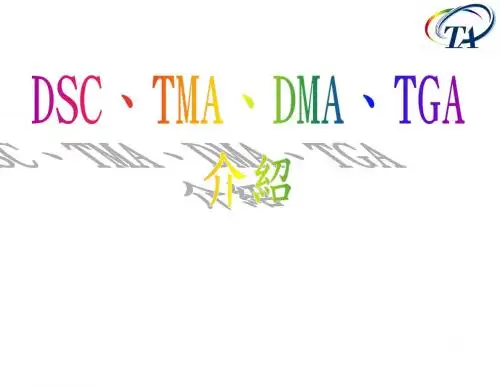
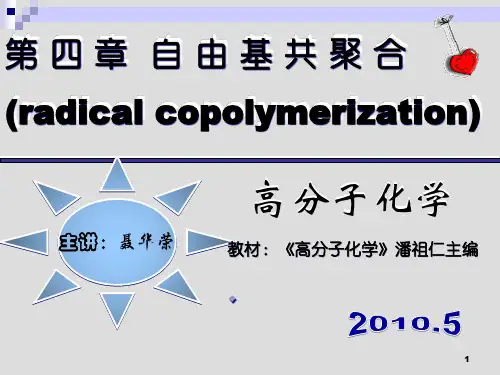
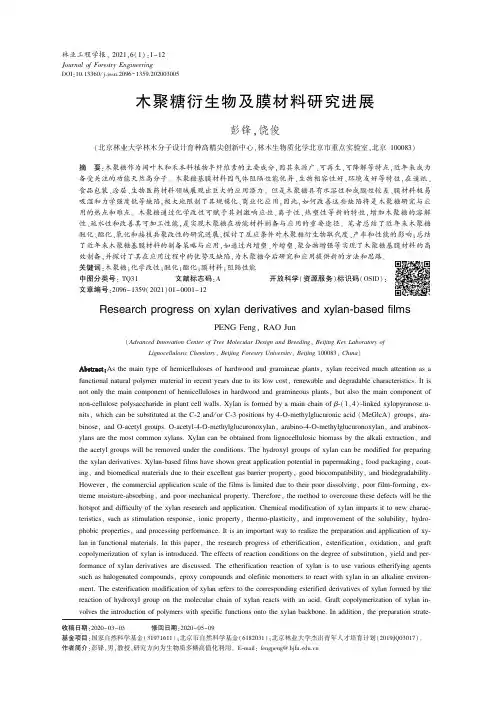
林业工程学报,2021,6(1):1-12JournalofForestryEngineeringDOI:10.13360/j.issn.2096-1359.202003005收稿日期:2020-03-03㊀㊀㊀㊀修回日期:2020-05-09基金项目:国家自然科学基金(31971611);北京市自然科学基金(6182031);北京林业大学杰出青年人才培育计划(2019JQ03017)㊂作者简介:彭锋,男,教授,研究方向为生物质多糖高值化利用㊂E⁃mail:fengpeng@bjfu.edu.cn木聚糖衍生物及膜材料研究进展彭锋,饶俊(北京林业大学林木分子设计育种高精尖创新中心,林木生物质化学北京市重点实验室,北京100083)摘㊀要:木聚糖作为阔叶木和禾本科植物半纤维素的主要成分,因其来源广㊁可再生㊁可降解等特点,近年来成为备受关注的功能天然高分子㊂木聚糖基膜材料因气体阻隔性能优异㊁生物相容性好㊁环境友好等特性,在造纸㊁食品包装㊁涂层㊁生物医药材料领域展现出巨大的应用潜力㊂但是木聚糖具有水溶性和成膜性较差㊁膜材料极易吸湿和力学强度低等缺陷,极大地限制了其规模化㊁商业化应用,因此,如何改善这些缺陷将是木聚糖研究与应用的热点和难点㊂木聚糖通过化学改性可赋予其刺激响应性㊁离子性㊁热塑性等新的特性,增加木聚糖的溶解性㊁疏水性和改善其可加工性能,是实现木聚糖在功能材料制备与应用的重要途径㊂笔者总结了近年来木聚糖醚化㊁酯化㊁氧化和接枝共聚改性的研究进展,探讨了反应条件对木聚糖衍生物取代度㊁产率和性能的影响;总结了近年来木聚糖基膜材料的制备策略与应用,如通过内增塑㊁外增塑㊁聚合物增强等实现了木聚糖基膜材料的高效制备,并探讨了其在应用过程中的优势及缺陷,为木聚糖今后研究和应用提供新的方法和思路㊂关键词:木聚糖;化学改性;醚化;酯化;膜材料;阻隔性能中图分类号:TQ31㊀㊀㊀㊀㊀文献标志码:A㊀㊀㊀㊀㊀开放科学(资源服务)标识码(OSID):文章编号:2096-1359(2021)01-0001-12Researchprogressonxylanderivativesandxylan⁃basedfilmsPENGFeng,RAOJun(AdvancedInnovationCenterofTreeMolecularDesignandBreeding,BeijingKeyLaboratoryofLignocellulosicChemistry,BeijingForestryUniversity,Beijing100083,China)Abstract:Asthemaintypeofhemicellulosesofhardwoodandgramineaeplants,xylanreceivedmuchattentionasafunctionalnaturalpolymermaterialinrecentyearsduetoitslowcost,renewableanddegradablecharacteristics.Itisnotonlythemaincomponentofhemicellulosesinhardwoodandgramineousplants,butalsothemaincomponentofnon⁃cellulosepolysaccharideinplantcellwalls.Xylanisformedbyamainchainofβ⁃(1,4)⁃linkedxylopyranoseu⁃nits,whichcanbesubstitutedattheC⁃2and/orC⁃3positionsby4⁃O⁃methylglucuronicacid(MeGlcA)groups,ara⁃binose,andO⁃acetylgroups.O⁃acetyl⁃4⁃O⁃methylglucuronoxylan,arabino⁃4⁃O⁃methylglucuronoxylan,andarabinox⁃ylansarethemostcommonxylans.Xylancanbeobtainedfromlignocellulosicbiomassbythealkaliextraction,andtheacetylgroupswillberemovedundertheconditions.Thehydroxylgroupsofxylancanbemodifiedforpreparingthexylanderivatives.Xylan⁃basedfilmshaveshowngreatapplicationpotentialinpapermaking,foodpackaging,coat⁃ing,andbiomedicalmaterialsduetotheirexcellentgasbarrierproperty,goodbiocompatibility,andbiodegradability.However,thecommercialapplicationscaleofthefilmsislimitedduetotheirpoordissolving,poorfilm⁃forming,ex⁃trememoisture⁃absorbing,andpoormechanicalproperty.Therefore,themethodtoovercomethesedefectswillbethehotspotanddifficultyofthexylanresearchandapplication.Chemicalmodificationofxylanimpartsittonewcharac⁃teristics,suchasstimulationresponse,ionicproperty,thermo⁃plasticity,andimprovementofthesolubility,hydro⁃phobicproperties,andprocessingperformance.Itisanimportantwaytorealizethepreparationandapplicationofxy⁃laninfunctionalmaterials.Inthispaper,theresearchprogressofetherification,esterification,oxidation,andgraftcopolymerizationofxylanisintroduced.Theeffectsofreactionconditionsonthedegreeofsubstitution,yieldandper⁃formanceofxylanderivativesarediscussed.Theetherificationreactionofxylanistousevariousetherifyingagentssuchashalogenatedcompounds,epoxycompoundsandolefinicmonomerstoreactwithxylaninanalkalineenviron⁃ment.Theesterificationmodificationofxylanreferstothecorrespondingesterifiedderivativesofxylanformedbythereactionofhydroxylgrouponthemolecularchainofxylanreactswithanacid.Graftcopolymerizationofxylanin⁃volvestheintroductionofpolymerswithspecificfunctionsontothexylanbackbone.Inaddition,thepreparationstrate⁃林业工程学报第6卷giesandapplicationsofxylan⁃basedfilmsarereviewed.Theefficientpreparationmethods,suchasinternalplasticiza⁃tion,externalplasticization,polymerreinforcement,areusedforachievingthexylan⁃basedfilms.Theadvantagesanddrawbacksofxylanintheapplicationprocessarediscussed,whichcanprovidenewdesignideasanddirectionsfortheresearchandapplicationofxylaninthefuture.Keywords:xylan;chemicalmodification;etherification;esterification;films;barrierproperty㊀㊀随着全球化石能源的日益短缺和环境污染问题的加剧,特别是近年来海洋生物体中微塑料的发现以及全球气候变暖,对发展和利用可持续㊁可再生㊁环境友好的新能源与材料的需求日益增加㊂因此,发展高效㊁可持续的清洁能源与材料是解决这一问题的重要途径,其中对生物质能和生物质基功能材料的研究已成为国内外的热点领域㊂近年来,基于农林生物质原料分离提取技术的迅速发展,使农林生物质原料在生物质能和功能材料上的应用表现出巨大的潜力,尤其是在生物乙醇㊁柔性电子器件㊁超吸附材料㊁生物医药以及包装涂层等领域已实现了高附加值利用㊂半纤维素含量在木质纤维生物质中占25% 35%,其结构与纤维素均一聚糖的直链结构不同,是由不同的单糖基以多种连接方式形成的具有复杂结构的聚糖,是一群复合聚糖的总称㊂根据其原料的来源不同,半纤维素的结构和含量也有明显差异㊂阔叶木半纤维素主要由葡萄糖醛酸木聚糖㊁葡甘露聚糖和木葡聚糖组成;针叶木半纤维素主要由半乳葡甘露聚糖㊁木聚糖和阿拉伯糖半乳聚糖组成;而禾本科植物半纤维素主要由阿拉伯糖葡萄糖醛酸木聚糖和β⁃(1,3)(1,4)⁃葡聚糖组成㊂木聚糖是广泛存在于植物细胞壁的天然聚多糖,不仅是阔叶木和禾本科植物半纤维素的主要成分,也是植物细胞壁中非纤维素聚多糖的主要组成部分㊂木聚糖主链是由D⁃吡喃型木糖基以β⁃(1,4)⁃糖苷键连接而成,侧链主要包括阿拉伯糖㊁4⁃O⁃甲基葡萄糖醛酸和O⁃乙酰基㊂根据侧链糖单元的不同,木聚糖主要分为聚⁃O⁃乙酰基⁃4⁃O⁃甲基葡萄糖醛酸基木糖㊁聚⁃阿拉伯糖⁃4⁃O⁃甲基葡萄糖醛酸基木糖和聚阿拉伯木糖㊂木聚糖膜具有独特的理化特性(良好生物相容性㊁生物可降解性和气体阻隔性),使其在药物缓释㊁包装材料㊁涂层和造纸添加剂等领域具有重要的应用价值㊂木聚糖分子链含有大量的羟基,导致其分子内和分子间具有强的氢键相互作用,使其在常见溶剂中只能润涨而难以溶解,限制了其可加工性;同时导致了其极易吸湿的特性,造成木聚糖基膜材料的力学性能大幅下降而限制了其应用㊂然而,由于木聚糖分子中大量羟基的存在,可对其进行化学改性赋予木聚糖特有的性能,如刺激响应性㊁电导性㊁疏水性㊁热塑性以及良好的加工性,从而克服木聚糖在实际应用中的缺陷㊂此外,在木聚糖基膜材料的制备过程中通常会引入塑化剂㊁聚合物和无机填料以改善膜材料的成膜性㊁疏水性㊁力学性能和热稳定性㊂如何将来源广㊁可再生㊁生物相容性好的木聚糖转化为功能材料,实现其高值化㊁规模化的应用,是今后研究的热点和难点㊂1㊀木聚糖的化学改性1.1㊀木聚糖的醚化改性木聚糖的羟基可与烷基化试剂反应生成木聚糖醚化衍生物,根据不同醚化产物使用不同的醚化试剂,如卤代物㊁环氧化合物及烯类单体(图1)㊂对木聚糖进行醚化改性可以改善木聚糖的水溶性㊁疏水性和表面活性等㊂木聚糖的醚化改性需要在强碱环境下使羟基去质子化,再与醚化试剂进行反应㊂在此过程中会导致木聚糖发生一定程度的降解,这也是木聚糖醚化过程中的主要弊端㊂为了减小醚化过程中木聚糖的降解对产物性能的影响,醚化反应一般在非均相体系中进行㊂木聚糖的醚化衍生物在制药㊁造纸助剂㊁热塑性材料㊁食品添加剂㊁造纸助剂和涂层等领域具有很大的应用潜力㊂图1㊀木聚糖醚化改性路径Fig.1㊀Reactionpathsforthepreparationofxylanderivativesviaetherification木聚糖羧甲基化是将阴离子引入木聚糖分子链的重要途径,不仅改善了其水溶性,也使其具有阴离子特性㊂Petzold等[1-2]对不同原料提取的木聚糖进行羧甲基改性,通过优化反应条件,制备出取代度为1.65的羧甲基木聚糖㊂此外,探讨了不同非均相体系(如NaOH/乙醇㊁NaOH/异丙醇)对2㊀第1期彭锋,等:木聚糖衍生物及膜材料研究进展取代度的影响㊂Alekhina等[3]在前人研究基础上优化了醚化反应条件,制备出了高取代度的羧甲基木聚糖㊂Peng等[4]在非均相体系(NaOH/乙醇)中借助微波辅助合成了羧甲基木聚糖,再将羧甲基木聚糖在微波辅助下与季铵化试剂反应生成两性木聚糖衍生物,与传统的加热法相比,微波辅助能在短时间内实现醚化产物的合成,且取代度能达到0.9㊂木聚糖的季铵化改性是赋予木聚糖阳离子特性的主要途径㊂季铵化改性之后的木聚糖不仅具有更好的水溶性,还可以与具有阴离子特性的高分子聚合物进行复合实现功能材料的制备㊂Ebringerová等[5]以3⁃氯⁃2⁃羟丙基三甲基氯化铵为醚化试剂在碱性环境(NaOH/H2O)下对木聚糖进行季铵化改性㊂结果表明,在最优反应条件下可以制备出取代度为0.51的季铵化木聚糖㊂Schwikal等[6]通过优化反应条件,在NaOH/1,2⁃二甲氧基乙烷体系中以2,3⁃环氧丙基三甲基氯化铵为季铵化试剂对木聚糖进行醚化改性,制备出高取代度(1.6)的季铵化木聚糖㊂Postma等[7]和Kong等[8]以季铵化木聚糖为造纸助剂,系统地研究了季铵化木聚糖对纸张性能的影响㊂结果表明,与阳离子淀粉助剂相比,添加季铵化木聚糖对纸张的抗张强度㊁耐撕裂度㊁耐破度和耐折度提升效果更为明显㊂在木聚糖分子链上引入苯环或烷基长链可以有效地改善木聚糖的疏水性㊂Ren等[9]系统分析了不同反应条件对苄基化木聚糖取代度和产率的影响,在最佳反应条件下制备出了取代度为0.35的苄基化木聚糖,该苄基化木聚糖在二甲基亚砜(DMSO)试剂中表现出良好的溶解性㊂与未改性的木聚糖相比,苯环的引入导致了苄基化木聚糖的热稳定性提升㊂Laine等[10]通过烷基化反应将烷基长链引入木聚糖,实现了木聚糖膜材料由亲水性向疏水性的转变㊂相对于传统的改性方法,木聚糖醚化改性的新方法涉及功能聚合物的设计与合成,如将含有不饱和碳碳双键或三键的功能单体引入到木聚糖形成前驱体,然后在催化剂的作用下引发功能单体聚合制备木聚糖基功能高分子聚合物㊂Peng等[11]利用开环反应将甲基丙烯酸缩水甘油醚接枝到木聚糖分子链,分析了不同反应条件对取代度㊁产率以及产物结构性能的影响㊂结果表明,醚化试剂与木聚糖的物质的量之比为9ʒ5,催化剂二甲氨基吡啶(DMAP)的用量为木聚糖质量的20%,在40ħ条件下反应36h即可制备出取代度为0.94的木聚糖醚化物㊂流变测试的结果表明,该木聚糖醚化物溶液呈现出剪切变稀的特性,且溶液的弹性模量随着取代度的提高而增加㊂Svärd等[12]首先通过开环反应将甲基丙烯酸缩水甘油醚引入到木聚糖分子链㊂然后,在催化剂的作用下与丙烯酸十八酯聚合生成相应的木聚糖醚化物㊂改性后的木聚糖基膜材料表现出良好的疏水性能和力学性能,接触角和断裂应变分别达到90ʎ和600%㊂因此,醚化改性可以赋予木聚糖离子特性,提升其溶解性和疏水性等,为木聚糖在聚合电解质㊁食品㊁造纸㊁包装材料㊁涂层和生物医药等领域的应用提供了保障,尤其是在先进功能材料(药物载体㊁超吸附和分离材料)上的制备与应用㊂木聚糖醚化衍生物的结构与反应条件见表1㊂表1㊀木聚糖醚化产物的结构及反应条件Table1㊀Thereactionconditionandstructureofxylanderivativesviaetherification编号产物结构反应条件参考文献1氢氧化钾/水氢氧化钠/丙酮[13-14]2氢氧化钠/水过硫酸钾/水醋酸/水[15]3氢氧化钠/水[10,16]4氢氧化钠/异丙醇[17]5氢氧化钠/1,2⁃二甲氧基乙烷氢氧化钠/水[6-7]6氢氧化钠/水氢氧化钠/乙醇氢氧化钠/异丙醇[1-4,18]3林业工程学报第6卷表1(续)编号产物结构反应条件参考文献7氢氧化钠/水[19]8氢氧化钠/水二甲基亚砜/4⁃二甲氨基吡啶[11-12]9二甲基亚砜/18⁃冠醚⁃6[9]10氢氧化钠/水[20-21]1.2㊀木聚糖的酯化改性木聚糖酯化改性一般是指木聚糖分子链上的羟基与酸反应生成相应的木聚糖酯化衍生物,以提高木聚糖的疏水性㊁热塑性和可加工性㊂酰基卤化物㊁酸酐和羧酸等均可与糖单元C2和C3位置上的羟基发生亲核取代反应,生成相应的木聚糖酯化衍生物㊂典型的木聚糖酯化改性如图2所示㊂首先是利用三乙胺(TEA)㊁DMAP㊁吡啶和氢氧化钠等对木聚糖的羟基进行活化,然后活化的羟基与酰基卤㊁酸酐和硫酸盐等反应生成木聚糖酯化衍生物㊂图2㊀木聚糖酯化反应路径Fig.2㊀Reactionpathsforthepreparationofxylanderivativesviaesterification木聚糖酯化改性涉及均相体系和非均相体系㊂因为木聚糖在一般溶剂中只能分散,难以溶解,早期的酯化改性主要是在非均相体系中进行的㊂1948年,Carson等[22]以甲酰胺溶液为溶剂,吡啶为催化剂,使用不同的酸酐和酰氯对不同原料的木聚糖进行酯化改性,制备出木聚糖丁酸酯㊁木聚糖月桂酸酯㊁木聚糖豆蔻酸酯和棕榈酸酯等㊂Sun等[23]以氢氧化钠为催化剂在水溶液中用琥珀酸对木聚糖进行酯化改性,系统地研究了不同反应条件对取代度和产率的影响㊂木聚糖琥珀酸酯在非均相体系的取代度仅为0.017 0.210,产率为40% 46%㊂研究者们发现在非均相体系中对木聚糖进行酯化改性时所需的反应条件均较苛刻,取代度和产率较低且产物性能较差㊂在均相体系下酯化改性可实现木聚糖酯化衍生物取代度㊁产率和结构的可控,因此,对均相体系的研究是木聚糖酯化改性的主要方向㊂常见的木聚糖酯化均相体系有二甲基甲酰胺(DMF)㊁N,N⁃二甲基乙酰胺/氯化锂(DMAc/LiCl)㊁二甲基亚砜/氯化锂(DMSO/LiCl)㊁二甲基亚砜/四氢呋喃(DMSO/THF)和各种离子液体如氯化1⁃丁基⁃3⁃甲基咪唑([Bmim]Cl)等㊂Daus等[24]先将木聚糖溶解在DMF中形成均相体系,用SO3/吡啶(Py)或SO3/DMF2种磺化体系对不同原料的木聚糖进行磺化反应生成木聚糖磺酸酯㊂结果表明,均相体系中木聚糖磺酸酯的取代度高达1.9㊂张雪琴[25]在二甲基亚砜/N⁃甲基咪唑(DMSO/NMI)均相体系中不添加任何催化剂的情况下,实现了木聚糖酯化衍生物的高效㊁高取代度和高产率的合成,木聚糖酯化物的取代度和产率分别为1.98%和86.88%,酯化改性之后木聚糖在DMSO㊁DMF和CHCl3的溶解度大幅提升㊂Wrigstedt等[26]在DMAc/LiCl均相体系中合成了木聚糖羟基肉桂酸酯,分析了不同反应条件与取代度和产率的关系,在最佳反应条件下木聚糖酯化物的取代度和产率分别为0.39%和65.8%,且该木聚糖酯化衍生物表现出一定的抗氧化性,在抗氧化剂领域具有一定的应用潜力㊂2007年,Ren等[27]第一次在离子液体中对半纤维素进行了均相酯化改性,在离子液体[Bmim]Cl中探究了不同反应条件对酰化半纤维素的产率和取代度的影响㊂半纤维素酯化物的最大取代度为1.53,改性后半纤维素的疏水性和热稳定性均得到了一定的提升㊂随后,Stepan等[28]分别在2种不同离子液体1⁃乙基⁃3⁃甲基咪唑磷酸二甲酯盐([emim][Me2PO4])和1,5⁃二氮杂双环[4.3.0]⁃5⁃壬烯醋酸盐([DBNH]OAc)中,实现了木聚糖快速乙酰化生成相应的高分子量木聚糖乙酸酯,反应时间可缩短至5min,取代度为1.96,且在三氯甲烷中具有良好的溶解性㊂Gericke等[29]用氯甲酸苯作酯化试剂分别在N⁃甲基咪唑/氯化锂(NMI/LiCl)和[Bmim]Cl4㊀第1期彭锋,等:木聚糖衍生物及膜材料研究进展体系中通过吡啶催化形成木聚糖碳酸酯,结果表明,在[Bmim]Cl/吡啶体系中酯化剂与木聚糖的物质的量之比为4ʒ1,反应时间为24h,木聚糖碳酸酯的取代度高达1.92,且在DMSO㊁DMF㊁DMAc和丙酮中具有很好的溶解性㊂此外,该木聚糖碳酸酯可以自组装形成直径100nm左右的纳米颗粒,在药物缓释和靶向治疗等领域表现出一定的应用潜力㊂木聚糖酯化改性另一途径是利用N,N⁃羰基二咪唑(CDI)先对酯化试剂进行活化,然后再和木聚糖的羟基进行酯化反应㊂Fu等[30]以木聚糖和硬脂酸为原料,用CDI对硬脂酸进行活化后,在二甲基亚砜/四丁基氟化铵体系中对木聚糖进行酯化,制备出取代度在0.34 1.54的木聚糖硬脂酸酯,并以酯化产物为原料通过透析法制备出pH响应型载药纳米粒子(215nm),该粒子对酮洛芬的最大负载量为64%,释放效果受环境pH影响,在pH11.0和2.0的环境中最大释放量分别为43.6%和53.8%㊂Daus等[31]先将布洛芬在DMSO分散溶解,加入CDI进行活化,然后和木聚糖在80ħ反应24h制备出取代度为1.24的木聚糖酯化衍生物㊂该木聚糖酯化物可以自组装形成直径为160 470nm的纳米微球,在药物缓释等领域具有很大的应用潜力㊂Kumar等[32]先将5⁃氨基水杨酸溶解分散在DMF中,在加入一定量的CDI进行活化,然后将一定量的木聚糖/DMSO溶液逐滴加入活化后的5⁃氨基水杨酸溶液进行酯化反应㊂该木聚糖酯化物的产率为95.37%,同样可自组装形成直径50nm左右的颗粒,体外药物释放的结果表明,该纳米颗粒可用于持续的靶向药物释放,释放速率与pH密切相关㊂因此,木聚糖酯化改性赋予了木聚糖新的功能特性,改善了其亲水性㊁成膜性和溶解性能,使其在功能材料(膜㊁纳米颗粒㊁凝胶等)上的制备成为可能,扩展了木聚糖的应用范围,特别是用于生产食品工业中的生物降解塑料㊁树脂㊁薄膜等㊂木聚糖酯化衍生物的结构及反应条件见表2㊂表2㊀木聚糖酯化产物的结构及反应条件Table2㊀Thereactionconditionandstructureofxylanderivativesviaesterification编号产物结构反应条件参考文献1甲酰胺/吡啶氯化1⁃丁基⁃3⁃甲基咪唑[22,27-28]2二甲基甲酰胺/氯化锂二甲基亚砜/N⁃甲基咪唑[25,33]3二甲基甲酰胺/氯化锂/4⁃二甲氨基吡啶[34]4二甲基甲酰胺/氯化锂/4⁃二甲氨基吡啶[35-36]5氯化1⁃丁基⁃3⁃甲基咪唑氢氧化钠/水[23,37]6二甲基甲酰胺/氯化锂/三氧化硫⁃吡啶三氧化硫⁃二甲基甲酰胺[24,38]7二甲基甲酰胺/氯化锂/4⁃二甲氨基吡啶/微波[39]8N⁃甲基吡咯烷酮/氯化锂/吡啶氯化1⁃丁基⁃3⁃甲基咪唑[29,40]5林业工程学报第6卷1.3㊀木聚糖的氧化改性木聚糖的氧化改性是将羧基和醛基化学反应活性基团引入木聚糖的主要途径㊂木聚糖的氧化产物取决于氧化剂的类型以及氧化条件㊂用于木聚糖氧化改性的常见氧化体系有高碘酸盐㊁H2O2/磺化酞菁铁(H2O2/FePcS)㊁HIO4/NaClO2㊁特异性氧化酶/NaClO2㊁NaNO2/H3PO4等㊂Matsumura等[41-42]的研究表明了HIO4/NaClO2体系在氧化过程中先在木聚糖的结构单元生成醛基,再通过Na⁃ClO2进一步氧化生成羧基㊂此外,Matsumura等[42]还利用特异性氧化酶/NaClO2体系对木聚糖进行氧化改性研究发现氧化过程中特异性酶可以将木聚糖结构单元上的羟基氧化生成醛基,在NaClO2的作用下进一步氧化生成羧基㊂Andersson等[43]利用NaNO2/H3PO4体系,采用一步法将羧基引入到木聚糖分子链中㊂氧化剂主要和糖单元C2㊁C3的邻位羟基反应生成相应的羧基,但是在氧化过程中木聚糖降解严重,分子链结构被破坏,限制了氧化产物的进一步应用㊂Börjesson等[44]和Amer等[45]的研究表明,高碘酸盐(高碘酸钠)是氧化木聚糖的理想氧化剂,主要是因为其选择性氧化邻位羟基(糖单元C2㊁C3邻位羟基)生成邻位醛基,在氧化过程中可以最大程度的保留木聚糖的分子链结构㊂Renault等[46]利用H2O2/FePcS体系氧化淀粉的经验,成功地在木聚糖的糖单元上同时引入了羧基和醛基㊂羧基和醛基的引入使木聚糖具有更高的化学反应活性,使其可以与富含氨基㊁羟基等聚合物进行组装实现木聚糖在功能材料方面的应用㊂木聚糖氧化衍生物的结构及反应条件见表3㊂表3㊀木聚糖氧化产物结构及反应条件Table3㊀Thereactionconditionandstructureofxylanderivativesviaoxidation编号产物结构反应条件参考文献1高碘酸/亚氯酸钠氢氧化钠/过氧化氢[41,47]2高碘酸钠[44-45]3过氧化氢/四磺酸基铁酞菁[46]1.4㊀木聚糖的接枝共聚改性木聚糖的接枝共聚改性是将具有特定功能的支链聚合物引入到木聚糖主链上㊂具体的实施方法有偶合接枝法和引发接枝法:偶合接枝法是将功能单体进行预聚合,然后通过预聚物的末端功能基团㊁偶联剂或交联剂与木聚糖分子链的活性基团反应形成木聚糖接枝聚合物;引发接枝法是先在木聚糖分子链上形成活性聚合中心,然后与功能单体进行可控的自由基聚合形成木聚糖接枝共聚物㊂常见的单体有丙烯酸㊁丙烯酰胺㊁甲基丙烯酸缩水甘油醚以及用于开环接枝聚合的丙交酯㊁己内酯等㊂木聚糖接枝共聚改性的早期研究主要是以苯乙烯㊁甲基丙烯酸甲酯㊁丙烯腈等功能单体通过硝酸铈铵㊁Fe2+/H2O2㊁过硫酸铵⁃硫代硫酸钠等引发体系与木聚糖或甲基化的木聚糖合成的木聚糖接枝共聚物[48-49]㊂然而,这些接枝共聚的方法存在诸多缺陷,如在反应过程中木聚糖降解严重,接枝率㊁产率和产物分子量无法得到有效控制㊂为了克服上述接枝共聚方法的缺点,实现木聚糖接枝共聚物高效㊁可靠的合成,研究者们开发了开环聚合和可控自由基聚合等聚合方法用于高效合成木聚糖接枝共聚物㊂Persson等[50]利用辛酸亚锡催化体系将L⁃丙交酯(PLA)通过开环聚合成功制备出木聚糖接枝共聚物(木聚糖⁃g⁃PLA)㊂结果表明,木聚糖分子链上的羟基取代度在0.7 1.7,且每个取代侧链含有1.2 2.5个PLA单元㊂与未改性的木聚糖相比,木聚糖⁃g⁃PLA具有优异的成膜性能,且膜材料具有较好的力学性能㊂Zhang等[51]和Farhat等[52]则以ε⁃己内酯为功能单体通过开环聚合制备出木聚糖接枝共聚物(木聚糖⁃g⁃PCL)㊂木聚糖⁃g⁃PCL共聚物表现出典型的热塑性,生物降解率高达95.3% 99.7%㊂木聚糖⁃g⁃PCL共聚物在环境友好㊁生物可降解的生物塑料产业具有较大的应有潜力㊂Peng等[53]和Wang等[54]合成了阳离子型的木聚糖接枝2⁃甲基丙烯酰氧基乙基三甲基氯化铵共聚物(木聚糖⁃METAC)和阴离子型的羧甲基木聚糖接枝环氧丙烷共聚物(CMX⁃g⁃PPO)㊂木聚糖⁃METAC共聚物在纺织絮凝剂具有潜在的6㊀第1期彭锋,等:木聚糖衍生物及膜材料研究进展应用,CMX⁃g⁃PPO共聚物因其具有良好的成膜性能㊁气体阻隔性能和力学性能,在食品包装和涂层材料上具有一定的应用价值㊂木聚糖接枝共聚物的结构与反应条件见表4㊂表4㊀典型的木聚糖接枝共聚物的结构及反应条件Table4㊀Thereactionconditionandstructureofxylanderivativesviagraftcopolymerization编号产物结构反应条件参考文献1硝酸铈铵Fe2+/过氧化氢/水[49,55]2异辛酸亚锡三氮杂双环癸稀脒/二甲基亚砜[56-57]3三氮杂双环癸稀脒/二甲基亚砜4⁃二甲氨基吡啶/氯化1⁃烯丙基⁃3⁃甲基咪唑[51-52,58]4硝酸铈铵/水[59]5溴化铜/五甲基二乙烯三胺/二甲基甲酰胺[60]6硝酸铈铵/硝酸/水[55]7过硫酸钾/水[54]8三异丙醇铝/氢氧化钠/异丙醇[53]9硫酸铜/抗坏血酸[61]2㊀木聚糖基膜材料的制备与应用目前广泛使用的包装材料主要是石油基聚乙烯㊁聚氯乙烯等膜材料㊂石油基膜材料在自然环境中很难被降解,所造成的白色污染给环境和生物链安全带来了极大的危害㊂同时,随着石油资源的日益消耗,最终将面临资源短缺问题㊂为了应对日益严重的环境污染和资源短缺等挑战,由可再生㊁可生物降解和来源广的生物质原料制备功能膜材料的研究受到了人们的广泛关注,其中木聚糖膜材料由于其良好的可再生性㊁可生物降解㊁阻氧性能受到人们的青睐,在食品㊁包装㊁农业㊁医药等领域有着极大的应用潜力㊂木聚糖由于分子内和分子间存在较强的氢键作用,导致了木聚糖膜材料在干燥过程中出现了内应力分布不均匀而开裂,很难获得连续致密的膜材料㊂因此,在木聚糖膜材料制备过程中提出了多种方法,如内增塑(化学改性)㊁外增塑(小分子塑化剂)㊁聚合物及无机填料增强等用以增加木聚糖的成膜性能㊁力学性能㊁疏水性以及阻隔性能㊂典型的木聚糖膜材料的主要组分㊁力学性能和阻隔性能见表5㊂7林业工程学报第6卷表5㊀木聚糖基膜材料的力学性能及阻隔性能Table5㊀Themechanicalpropertiesandoxygenpermeabilityofxylan⁃basedfilms编号主要组分拉伸应力/MPa断裂应变/%水蒸气透过率/(g㊃mm㊃m-2㊃d-1㊃kPa-1)氧气透过率/(cm3㊃μm㊃m-2㊃d-1㊃kPa-1)参考文献1阿拉伯木聚糖+山梨醇㊁甘油5.0 27.04.0 10.51.10 41.003.000 7.400[63]2阿拉伯葡萄糖醛酸木聚糖+山梨醇26.0 57.02.7 4.3-0.120 0.170[64]3葡萄糖醛酸木聚糖+木糖醇㊁山梨醇4.0 42.02.0 13.0-0.210[65]4拉伯木聚糖+细菌纳米纤维素32.0 68.02.1 8.1--[66]5木聚糖+磺化纤维素纳米晶---0.180[67]6羧甲基木聚糖+羧甲基纤维素5.0 58.03.0 8.019.00 38.006.000 23.000[3]7木聚糖+壳聚糖56.0 71.01.7 4.4-7.300 9.450[68]84⁃O⁃甲基葡萄糖醛酸木聚糖+壳聚糖+甘油10.0 23.12.6 12.2-0.010 0.265[69]9木聚糖+聚乙烯醇+TiO219.7 30.7170.0 327.02.99 5.33-[70]10阿拉伯木聚糖+乙二醇/甘油/山梨醇9.7 60.75.5 12.12.16 4.84-[71]11木聚糖+纤维素纳米纤维+山梨醇11.9 39.51.4 3.4--[72]12木聚糖接枝聚环氧丙烷+壳聚糖3.2 27.82.0 17.2--[53]13木聚糖+聚乙烯醇+柠檬酸7.6 49.35.8 249.02.03 2.55-[73]14木聚糖+纤维素纳米纤维+甘油㊁山梨醇㊁乙酸乙酯18.0 83.00.6 12.30.28 9.070.048 206.000[74]15木聚糖+聚乙烯醇+ZnO㊁SiO220.4 22.5200.0 260.02.85 3.625.000 6.800[76]㊀注: - 表示没有相关数据㊂2.1㊀内增塑内增塑主要涉及木聚糖的化学改性如醚化㊁酯化㊁接枝共聚等,化学改性赋予了木聚糖离子性和塑性,改善了木聚糖的溶解性㊁成膜性㊁疏水性和可加工性等,从而制备出性能优异的木聚糖膜材料㊂Fundador等[34]在均相体系通过酯化改性制备出含有不同长度烷基侧链的木聚糖酯化物㊂氯仿是该木聚糖酯化物的良溶剂,采用流延成膜的方法制备出了连续致密的木聚糖膜材料㊂随着烷基侧链的长度的增加,膜材料的疏水性能有明显的提升,最大接触角为99ʎ㊂膜材料的断裂应力和应变分别为29MPa和44%;断裂应力和模量随着烷基侧链长度的增加而降低,断裂应变随着烷基侧链长度的增加而增加㊂这主要是因为烷基侧链长度的增加降低了相邻木聚糖主链的结合强度,而侧链在相邻木聚糖主链之间充当了增韧剂,使膜材料表现出一定的柔韧性㊂Laine等[10]通过醚化反应将烷基长链引入到木聚糖主链上,大幅提升了木聚糖膜材料的疏水性能,木聚糖膜材料的最大接触角为112ʎ,实现了木聚糖膜材料由亲水性向疏水性的转变㊂该木聚糖膜材料的阻隔性能要优于商用的聚对苯二甲酸乙二醇酯,其氧气透过率和水蒸气透过率分别为37cm3㊃μm/(m2㊃d㊃kPa)和12g㊃mm/(m2㊃d㊃kPa)㊂优异的阻隔性能使其在食品包装和涂层等领域具有一定的应用前景㊂接枝共聚改性也是将烷基长链引入木聚糖的重要途径㊂Zhang等[51]研究了3种均相体系(DMF/LiCl㊁DMAc/LiCl㊁N⁃甲基吡咯烷酮/LiCl)下合成木聚糖接枝共聚物的最佳反应条件,以及不同接枝共聚物对膜材料性能的影响㊂结果表明,随着烷基侧链长度的增加,膜材料的断裂应力和杨氏模量下降,而断裂应变会大幅增加㊂该木聚糖衍生物膜材料的热稳定性也会随着烷基侧链长度的增加而增加㊂Šimkovic等[76]对木聚糖进行酯化改性制备出不同取代度的木聚糖硫酸酯化物,结果表明,取代度越高其木聚糖硫酸酯化物的分子量越低㊂通过流延法制备的木聚糖膜材料的力学性能随着取代度的增加而降低,主要是因为分子量的降低直8。
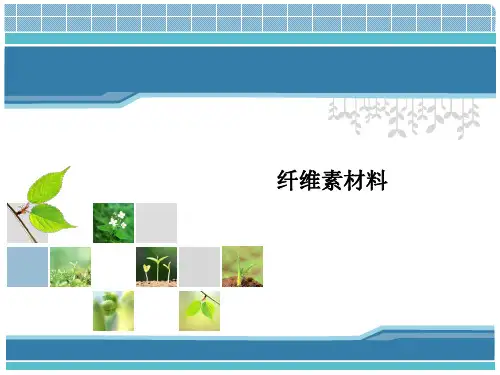
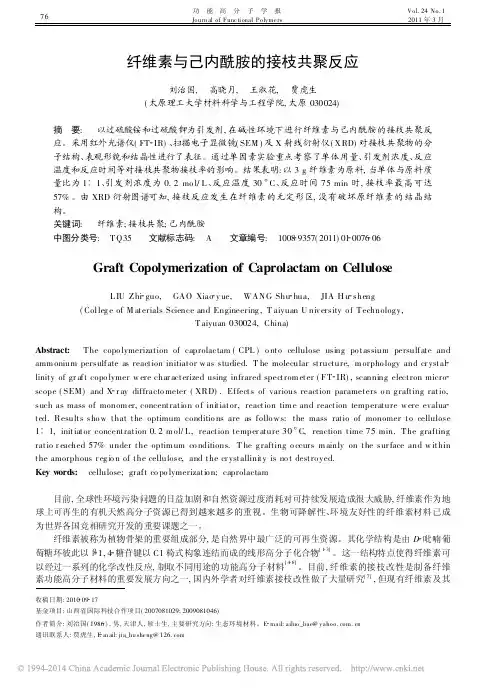
功 能 高 分 子 学 报Journ al of Functional Polymers Vol.24No.12011年3月收稿日期:2010 09 17基金项目:山西省国际科技合作项目(2007081029;2009081046)作者简介:刘治国(1986 ),男,天津人,硕士生,主要研究方向:生态环境材料。
E mail:ailuo_bae@通讯联系人:贾虎生,E m ail:jia_hu sheng@ 纤维素与己内酰胺的接枝共聚反应刘治国, 高晓月, 王淑花, 贾虎生(太原理工大学材料科学与工程学院,太原030024)摘 要: 以过硫酸铵和过硫酸钾为引发剂,在碱性环境下进行纤维素与己内酰胺的接枝共聚反应。
采用红外光谱仪(FT IR)、扫描电子显微镜(SEM )及X 射线衍射仪(XRD)对接枝共聚物的分子结构、表观形貌和结晶性进行了表征。
通过单因素实验重点考察了单体用量、引发剂浓度、反应温度和反应时间等对接枝共聚物接枝率的影响。
结果表明:以3g 纤维素为原料,当单体与原料质量比为1 1、引发剂浓度为0.2mo l/L 、反应温度30 C 、反应时间75min 时,接枝率最高可达57%。
由XRD 衍射图谱可知,接枝反应发生在纤维素的无定形区,没有破坏原纤维素的结晶结构。
关键词: 纤维素;接枝共聚;己内酰胺中图分类号: TQ35 文献标志码: A 文章编号: 1008 9357(2011)01 0076 06Graft Copolymerization of Caprolactam on CelluloseLIU Zhi guo, GAO Xiao y ue, WANG Shu hua, JIA H u sheng(Colleg e of M aterials Science and Engineering ,T aiyuan U niv ersity o f Technolog y,Taiyuan 030024,China)Abstract: The copo lymerization of caprolactam (CPL )o nto cellulose using po tassium persulfate and amm onium persulfate as reaction initiator w as studied.T he molecular structure,m orpho logy and cr ystal linity of gr aft copo lymer w ere char acterized using infrared spectrom eter (FT IR),scanning electron micro scope (SEM)and X r ay diffracto meter (XRD).Effects of various reaction parameters o n g rafting ratio,such as mass of monom er,concentratio n o f initiator,reaction tim e and reaction temperature w ere evalua ted.Results sho w that the optimum conditio ns are as follo w s:the mass ratio of monomer to cellulose 1 1,initiator concentration 0.2m ol/L,reaction temper ature 30 C,reaction time 75min.The grafting ratio r eached 57%under the optim um co nditions.T he g rafting o ccurs m ainly on the sur face and w ithin the amorphous r eg io n of the cellulose,and the cr ystallinity is no t destro yed.Key w ords: cellulose;graft co po lymerizatio n;caprolactam目前,全球性环境污染问题的日益加剧和自然资源过度消耗对可持续发展造成很大威胁,纤维素作为地球上可再生的有机天然高分子资源已得到越来越多的重视。
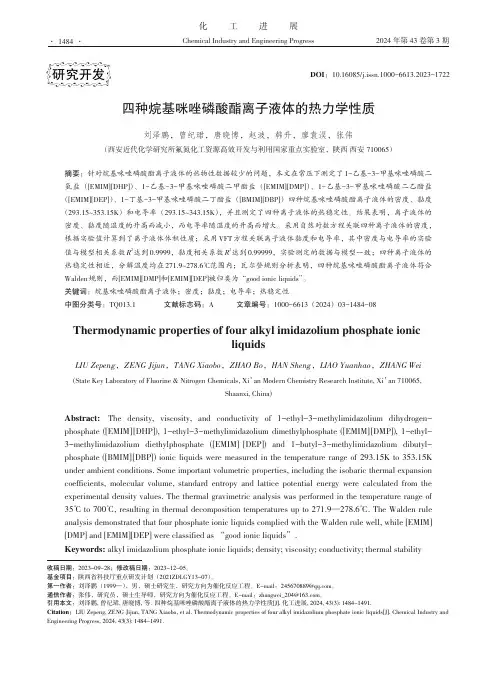
化工进展Chemical Industry and Engineering Progress2024 年第 43 卷第 3 期四种烷基咪唑磷酸酯离子液体的热力学性质刘泽鹏,曾纪珺,唐晓博,赵波,韩升,廖袁淏,张伟(西安近代化学研究所氟氮化工资源高效开发与利用国家重点实验室,陕西 西安 710065)摘要:针对烷基咪唑磷酸酯离子液体的热物性数据较少的问题,本文在常压下测定了1-乙基-3-甲基咪唑磷酸二氢盐([EMIM][DHP])、1-乙基-3-甲基咪唑磷酸二甲酯盐([EMIM][DMP])、1-乙基-3-甲基咪唑磷酸二乙酯盐([EMIM][DEP])、1-丁基-3-甲基咪唑磷酸二丁酯盐([BMIM][DBP])四种烷基咪唑磷酸酯离子液体的密度、黏度(293.15~353.15K )和电导率(293.15~343.15K ),并且测定了四种离子液体的热稳定性。
结果表明,离子液体的密度、黏度随温度的升高而减小,而电导率随温度的升高而增大。
采用自然对数方程关联四种离子液体的密度,根据实验值计算到了离子液体体积性质;采用VFT 方程关联离子液体黏度和电导率,其中密度与电导率的实验值与模型相关系数R 2达到0.9999,黏度相关系数R 2达到0.99999,实验测定的数据与模型一致;四种离子液体的热稳定性相近,分解温度均在271.9~278.6℃范围内;瓦尔登规则分析表明,四种烷基咪唑磷酸酯离子液体符合Walden 规则,而[EMIM][DMP]和[EMIM][DEP]被归类为“good ionic liquids ”。
关键词:烷基咪唑磷酸酯离子液体;密度;黏度;电导率;热稳定性中图分类号:TQ013.1 文献标志码:A 文章编号:1000-6613(2024)03-1484-08Thermodynamic properties of four alkyl imidazolium phosphate ionicliquidsLIU Zepeng ,ZENG Jijun ,TANG Xiaobo ,ZHAO Bo ,HAN Sheng ,LIAO Yuanhao ,ZHANG Wei(State Key Laboratory of Fluorine & Nitrogen Chemicals, Xi ’an Modern Chemistry Research Institute, Xi ’an 710065,Shaanxi, China)Abstract: The density, viscosity, and conductivity of 1-ethyl-3-methylimidazolium dihydrogen-phosphate ([EMIM][DHP]), 1-ethyl-3-methylimidazolium dimethylphosphate ([EMIM][DMP]), 1-ethyl-3-methylimidazolium diethylphosphate ([EMIM][DEP]) and 1-butyl-3-methylimidazolium dibutyl-phosphate ([BMIM][DBP]) ionic liquids were measured in the temperature range of 293.15K to 353.15K under ambient conditions. Some important volumetric properties, including the isobaric thermal expansion coefficients, molecular volume, standard entropy and lattice potential energy were calculated from the experimental density values. The thermal gravimetric analysis was performed in the temperature range of 35℃ to 700℃, resulting in thermal decomposition temperatures up to 271.9—278.6℃. The Walden rule analysis demonstrated that four phosphate ionic liquids complied with the Walden rule well, while [EMIM][DMP] and [EMIM][DEP] were classified as “good ionic liquids ”.Keywords: alkyl imidazolium phosphate ionic liquids; density; viscosity; conductivity; thermal stability研究开发DOI :10.16085/j.issn.1000-6613.2023-1722收稿日期:2023-09-28;修改稿日期:2023-12-05。
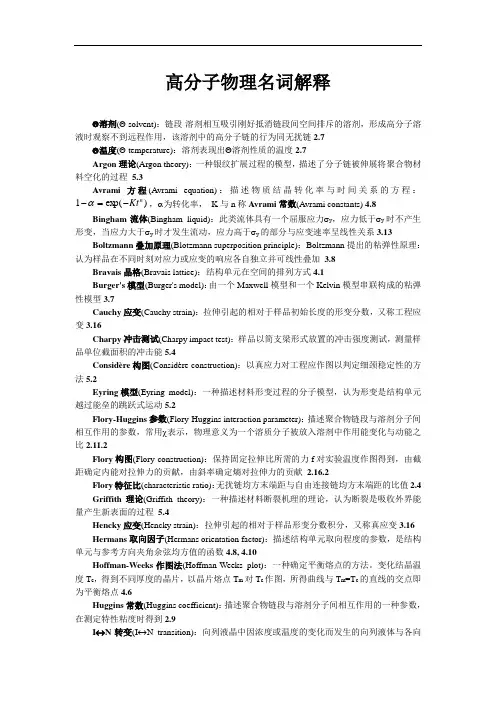
高分子物理名词解释Θ溶剂(Θ solvent):链段-溶剂相互吸引刚好抵消链段间空间排斥的溶剂,形成高分子溶液时观察不到远程作用,该溶剂中的高分子链的行为同无扰链2.7Θ温度(Θ temperature):溶剂表现出Θ溶剂性质的温度2.7Argon理论(Argon theory):一种银纹扩展过程的模型,描述了分子链被伸展将聚合物材料空化的过程5.3Avrami方程(Avrami equation):描述物质结晶转化率与时间关系的方程:--α,α为转化率,K与n称Avrami常数(Avrami constants) 4.8 =Kt1n)ex p(Bingham流体(Bingham liquid):此类流体具有一个屈服应力σy,应力低于σy时不产生形变,当应力大于σy时才发生流动,应力高于σy的部分与应变速率呈线性关系3.13 Boltzmann叠加原理(Blotzmann superposition principle):Boltzmann提出的粘弹性原理:认为样品在不同时刻对应力或应变的响应各自独立并可线性叠加 3.8Bravais晶格(Bravais lattice):结构单元在空间的排列方式4.1Burger's模型(Burger's model):由一个Maxwell模型和一个Kelvin模型串联构成的粘弹性模型3.7Cauchy应变(Cauchy strain):拉伸引起的相对于样品初始长度的形变分数,又称工程应变3.16Charpy冲击测试(Charpy impact test):样品以简支梁形式放置的冲击强度测试,测量样品单位截面积的冲击能5.4Considère构图(Considère construction):以真应力对工程应作图以判定细颈稳定性的方法5.2Eyring模型(Eyring model):一种描述材料形变过程的分子模型,认为形变是结构单元越过能垒的跳跃式运动5.2Flory-Huggins参数(Flory-Huggins interaction parameter):描述聚合物链段与溶剂分子间相互作用的参数,常用χ表示,物理意义为一个溶质分子被放入溶剂中作用能变化与动能之比2.11.2Flory构图(Flory construction):保持固定拉伸比所需的力f对实验温度作图得到,由截距确定内能对拉伸力的贡献,由斜率确定熵对拉伸力的贡献2.16.2Flory特征比(characteristic ratio):无扰链均方末端距与自由连接链均方末端距的比值2.4 Griffith理论(Griffith theory):一种描述材料断裂机理的理论,认为断裂是吸收外界能量产生新表面的过程5.4Hencky应变(Hencky strain):拉伸引起的相对于样品形变分数积分,又称真应变3.16 Hermans取向因子(Hermans orientation factor):描述结构单元取向程度的参数,是结构单元与参考方向夹角余弦均方值的函数4.8, 4.10Hoffman-Weeks作图法(Hoffman-Weeks plot):一种确定平衡熔点的方法。
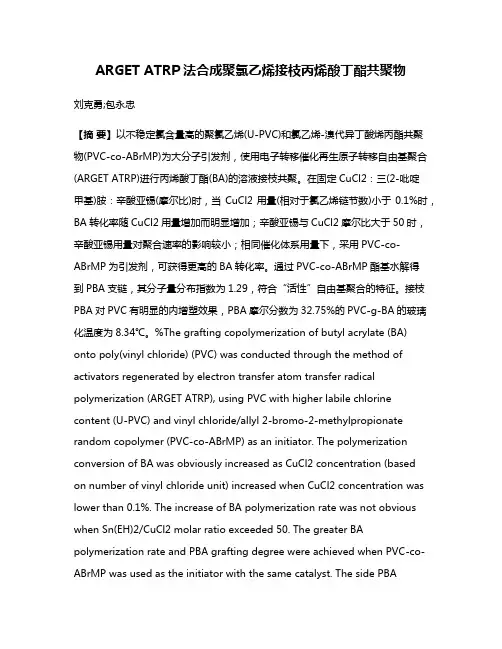
ARGET ATRP法合成聚氯乙烯接枝丙烯酸丁酯共聚物刘克勇;包永忠【摘要】以不稳定氯含量高的聚氯乙烯(U-PVC)和氯乙烯-溴代异丁酸烯丙酯共聚物(PVC-co-ABrMP)为大分子引发剂,使用电子转移催化再生原子转移自由基聚合(ARGET ATRP)进行丙烯酸丁酯(BA)的溶液接枝共聚。
在固定CuCl2:三(2-吡啶甲基)胺:辛酸亚锡(摩尔比)时,当CuCl2用量(相对于氯乙烯链节数)小于0.1%时,BA转化率随CuCl2用量增加而明显增加;辛酸亚锡与CuCl2摩尔比大于50时,辛酸亚锡用量对聚合速率的影响较小;相同催化体系用量下,采用PVC-co-ABrMP为引发剂,可获得更高的BA转化率。
通过PVC-co-ABrMP酯基水解得到PBA支链,其分子量分布指数为1.29,符合“活性”自由基聚合的特征。
接枝PBA对PVC有明显的内增塑效果,PBA摩尔分数为32.75%的PVC-g-BA的玻璃化温度为8.34℃。
%The grafting copolymerization of butyl acrylate (BA) onto poly(vinyl chloride) (PVC) was conducted through the method of activators regenerated by electron transfer atom transfer radical polymerization (ARGET ATRP), using PVC with higher labile chlorine content (U-PVC) and vinyl chloride/allyl 2-bromo-2-methylpropionate random copolymer (PVC-co-ABrMP) as an initiator. The polymerization conversion of BA was obviously increased as CuCl2 concentration (basedon number of vinyl chloride unit) increased when CuCl2 concentration was lower than 0.1%. The increase of BA polymerization rate was not obvious when Sn(EH)2/CuCl2 molar ratio exceeded 50. The greater BA polymerization rate and PBA grafting degree were achieved when PVC-co-ABrMP was used as the initiator with the same catalyst. The side PBAchains were cleaved from the ester group of PVC-co-ABrMP and the molecular weight distribution index of PBA was 1.29, verifying the “living”nature of this graft copolymerization. The gr afted PBA showed good internal plasticization effect on PVC, and the glass temperature of PVC-g-BA copolymer with 32.75%(mol) PBA was reduced to 8.34℃.【期刊名称】《化工学报》【年(卷),期】2014(000)008【总页数】7页(P3261-3267)【关键词】聚合;反应动力学;催化剂;聚氯乙烯;丙烯酸丁酯;接枝【作者】刘克勇;包永忠【作者单位】浙江大学化学工程与生物工程学系,化学工程联合国家重点实验室,浙江杭州 310027;浙江大学化学工程与生物工程学系,化学工程联合国家重点实验室,浙江杭州 310027【正文语种】中文【中图分类】TQ325.3以聚氯乙烯(PVC)为基体接枝软单体是合成增塑效果稳定的软质PVC的重要方法[1]。
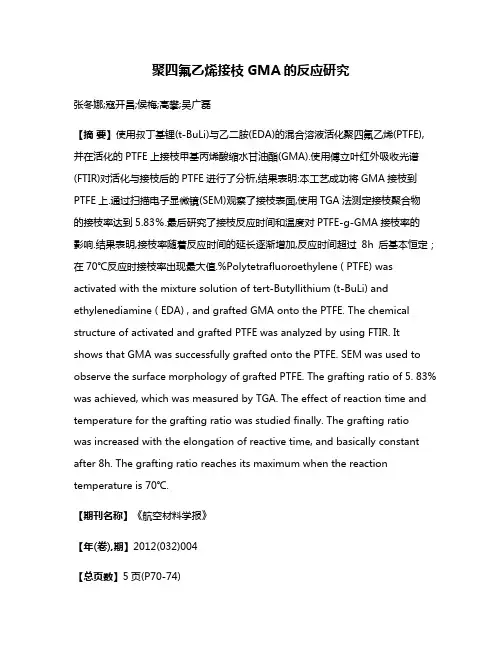
聚四氟乙烯接枝GMA的反应研究张冬娜;寇开昌;侯梅;高攀;吴广磊【摘要】使用叔丁基锂(t-BuLi)与乙二胺(EDA)的混合溶液活化聚四氟乙烯(PTFE),并在活化的PTFE上接枝甲基丙烯酸缩水甘油酯(GMA).使用傅立叶红外吸收光谱(FTIR)对活化与接枝后的PTFE进行了分析,结果表明:本工艺成功将GMA接枝到PTFE上.通过扫描电子显微镜(SEM)观察了接枝表面,使用TGA法测定接枝聚合物的接枝率达到5.83%.最后研究了接枝反应时间和温度对PTFE-g-GMA接枝率的影响.结果表明,接枝率随着反应时间的延长逐渐增加,反应时间超过8h后基本恒定;在70℃反应时接枝率出现最大值.%Polytetrafluoroethylene ( PTFE) was activated with the mixture solution of tert-Butyllithium (t-BuLi) and ethylenediamine ( EDA) , and grafted GMA onto the PTFE. The chemical structure of activated and grafted PTFE was analyzed by using FTIR. It shows that GMA was successfully grafted onto the PTFE. SEM was used to observe the surface morphology of grafted PTFE. The grafting ratio of 5. 83% was achieved, which was measured by TGA. The effect of reaction time and temperature for the grafting ratio was studied finally. The grafting ratiowas increased with the elongation of reactive time, and basically constant after 8h. The grafting ratio reaches its maximum when the reaction temperature is 70℃.【期刊名称】《航空材料学报》【年(卷),期】2012(032)004【总页数】5页(P70-74)【关键词】聚四氟乙烯;甲基丙烯酸缩水甘油酯;接枝;接枝率【作者】张冬娜;寇开昌;侯梅;高攀;吴广磊【作者单位】西北工业大学理学院,西安710129;西北工业大学理学院,西安710129;西北工业大学理学院,西安710129;西北工业大学理学院,西安710129;西北工业大学理学院,西安710129【正文语种】中文【中图分类】T0325.4聚四氟乙烯(PTFE)具有优异的耐热、耐寒、耐化学药品性及自润滑性,并具有特殊的电性能、表面特性和低摩擦系数等特点,已广泛应用于国防、军工、航空航天、汽车、石油化工等许多领域[1,2]。
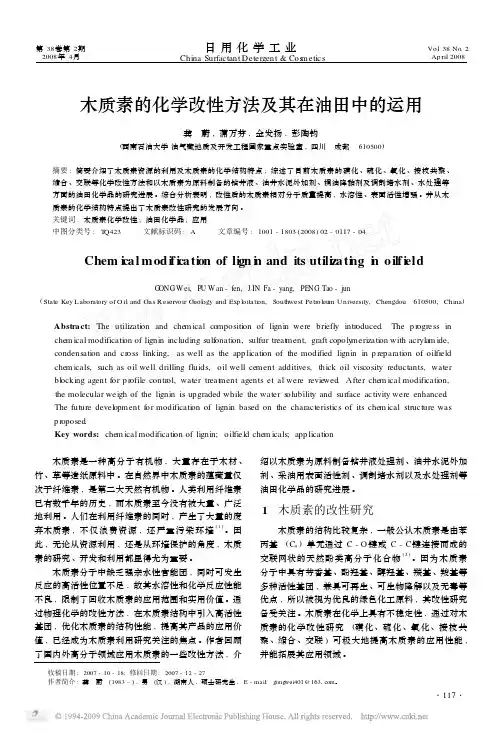
第38卷第2期2008年4月 日用化学工业China Surfactant Detergent &Cos metics Vol .38No .2Ap ril 2008收稿日期:2007-10-18;修回日期:2007-12-27作者简介:龚 蔚(1983-),男(汉),湖南人,硕士研究生,E -mail:gong wei401@1631com 。
木质素的化学改性方法及其在油田中的运用龚 蔚,蒲万芬,金发扬,彭陶钧(西南石油大学油气藏地质及开发工程国家重点实验室,四川 成都 610500)摘要:简要介绍了木质素资源的利用及木质素的化学结构特点;综述了目前木质素的磺化、硫化、氧化、接枝共聚、缩合、交联等化学改性方法和以木质素为原料制备的钻井液、油井水泥外加剂、稠油降黏剂及调剖堵水剂、水处理等方面的油田化学品的研究进展。
综合分析表明,改性后的木质素相对分子质量提高,水溶性、表面活性增强。
并从木质素的化学结构特点提出了木质素改性研究的发展方向。
关键词:木质素化学改性;油田化学品;应用中图分类号:T Q423 文献标识码:A 文章编号:1001-1803(2008)02-0117-04Chem i cal modi fi cati on of li gn i n and its utili zati n g i n oilfi eldG ONGW ei,PU W an -fen,J IN Fa -yang,PENG Tao -jun(State Key Laborat ory of O il and Gas Reservoir Geol ogy and Exp l oitati on,South west Petr oleu m University,Chengdou 610500,China )Abstract:The utilizati on and che m ical compositi on of lignin were briefly intr oduced .The p r ogress inche m ical modificati on of lignin including sulf onati on,sulfur treat m ent,graft copoly merizati on with acryla m ide,condensati on and cr oss linking,as well as the app licati on of the modified lignin in p reparati on of oilfield che m icals,such as oil well drilling fluids,oil well ce ment additives,thick oil viscosity reductants,water bl ocking agent for p r ofile contr ol,water treat m ent agents et al were revie wed .After che m ical modificati on,the molecular weigh of the lignin is upgraded while the water s olubility and surface activity were enhanced .The future devel opment f or modificati on of lignin based on the characteristics of its che m ical structure was p r oposed .Key words:che m ical modificati on of lignin;oilfield che m icals;app licati on 木质素是一种高分子有机物,大量存在于木材、竹、草等造纸原料中。
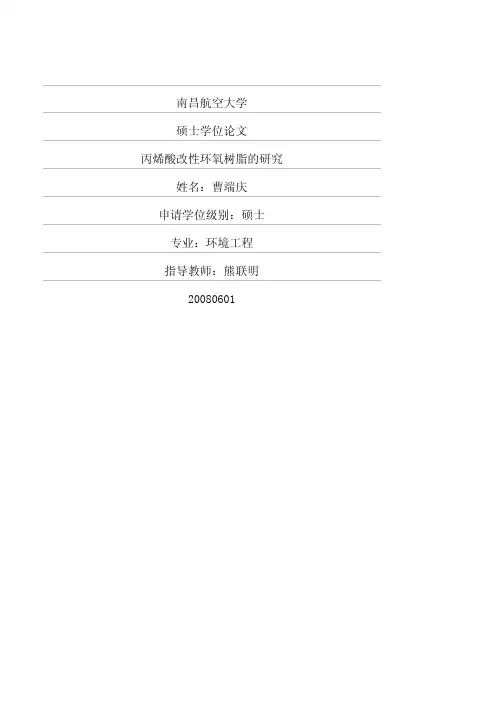
研究与开发CHINA SYNTHETIC RESIN AND PLASTICS合 成 树 脂 及 塑 料 , 2023, 40(6): 7芯片制造业是关系到我国国民经济发展的重要支柱产业。
芯片的制造包括光刻、刻蚀、封装等工序,光刻是整个集成电路制造中最关键且难度最大的一环,光刻工艺的发展水平直接决定集成电路的集成程度[1]。
光刻胶是基底上具有抗刻蚀性的光敏保护膜[2],也是光刻胶体系的支撑部分,主要由成膜树脂、感光剂、溶剂、助剂等组成[3]。
光刻胶由早期的g-线、i-线,发展成为目前以聚对羟基苯乙烯(PHS)衍生物为成膜树脂、曝光波长为248 nm及以聚甲基丙烯酸酯类为主、曝光波长为193 nm的光刻胶体系[4-7]。
其中,PHS作为248 nm光刻胶成膜树脂,在248 nm波长下透光性好,且化学结构中存在大量苯环,使其具备优异4-叔丁氧基苯乙烯-苯乙烯共聚物的合成吕 航,赵忠夫,王茧桦,韩春影,张春庆*(大连理工大学 化工学院,辽宁 大连 116024)摘要:采用活性阴离子聚合方法,以四氢呋喃(THF)/环己烷(CYX)为溶剂、正丁基锂为引发剂,苯乙烯与4-叔丁氧基苯乙烯为单体合成4-叔丁氧基苯乙烯-苯乙烯共聚物,并表征了其结构与性能。
结果表明:-78 ℃,THF为溶剂时,4-叔丁氧基苯乙烯-苯乙烯共聚物相对分子质量分布指数(PDI)为1.23,共聚过程中4-叔丁氧基苯乙烯活性高于苯乙烯;m(THF)∶m(CYX)=5∶5的THF/CYX为溶剂,-30 ℃下所得4-叔丁氧基苯乙烯-苯乙烯共聚物的PDI为1.10,相对分子质量分布更窄且有利于降低聚合成本;4-叔丁氧基苯乙烯-苯乙烯共聚物的玻璃化转变温度(t g)均低于4-叔丁氧基苯乙烯均聚物,4-叔丁氧基苯乙烯含量越高,4-叔丁氧基苯乙烯-苯乙烯共聚物的t g越高。
关键词:阴离子聚合 苯乙烯 4-叔丁氧基苯乙烯 二元共聚合中图分类号:TQ 334.3文献标志码: B 文章编号:1002-1396(2023)06-0007-05Synthesis of 4-tert-butoxystyrene-styrene copolymerLü Hang,Zhao Zhongfu,Wang Jianhua,Han Chunying,Zhang Chunqing(School of Chemical Engineering,Dalian University of Technology,Dalian 116024,China)Abstract:The 4-tert-butoxystyrene-styrene copolymer was prepared via living anionic polymerization with tetrahydrofuran(THF)/cyclohexane(CYX) as solvent,n-BuLi as initiator,styrene and 4-tert-butoxystyrene as monomers,whose structure and performance were characterized. The results show that the molecular mass distribution index (PDI) of 4-tert-butoxystyrene-styrene copolymer obtained at -78 ℃ and THF as solvent is 1.23. The activity of 4-tert-butoxystyrene is higher than that of styrene during the copolymerization process. The PDI of the 4-tert-butoxystyrene-styrene copolymer is 1.10 at -30 ℃ when the mass ratio of THF and CYX is 5∶5. The molecular mass distribution of copolymer is narrower and polymerization costs is reduced. The glass transition temperature(t g) of the 4-tert-butoxystyrene-styrene copolymer is lower than that of the 4-tert-butoxystyrene homopolymer. The higher the 4-tert-butoxystyrene content is,the higher the t g of the 4-tert-butoxystyrene-styrene copolymer is.Keywords:anionic polymerization; styrene;4-tert-butoxystyrene; binary copolymerization收稿日期:2023-05-27;修回日期:2023-08-26。
Chenmical Intermediate当代化工研究86科研开发2016·11淀粉系接枝丙烯酸SAP的制备及性能的研究*杨妹 张智达 黄月旺 钟家强 肖方可(西北民族大学化工学院 甘肃 730300)摘要:本实验采用间歇法溶液聚合制备淀粉系接枝丙烯酸的高吸水树脂,通过吸水率来选择最优合成条件。
主要探讨了丙烯酸中和度,丙烯酸与淀粉的质量配比,淀粉与水的质量配比,引发剂与丙烯酸的质量配比,接枝共聚时的反应温度。
糊化反应温度65℃,糊化反应时间为30min,淀粉与水的质量配比1:12,淀粉与丙烯酸的质量配比1:5,丙烯酸的中和度是68%,引发剂用量为1.0%,接枝共聚反应温度为55℃为合成产物的最佳反应条件。
关键词:SAP;吸液倍率;研究中图分类号:T 文献标识码:AStudy of properties and preparation of SAP of starch-g-acrylic acidYang Mei, Zhang Zhi-da, Huang Yue-wang, Zhong Jia-qiang, Xiao Fang-ke(School of Management of Northwest University for Nationalitie. Chemical Engineering Institute,Gansu,730300)Abstract :A high water absorbing resin of starch-g-acrylic acid was prepared by intermittent solution polymerization. The optimal syntheticconditions like neutralization degrees of acrylic acid, the mass ratio of acrylic acid and starch, the mass ratio of starch and water, the mass ratio of initiator and acrylic acid, the reaction temperature of graft-copolymerization were studied by the index of water absorbing. The results show that the water absorbing resin had the best performance when gelatinization temperature is 65 ℃, gelatinization time is 30 min, the mass ratio of starch and water is 1:12, the mass ratio of starch and acrylic acid is 1:5, the neutralization degrees of acrylic acid is 68 %, the content of initiator is 1.0 %, the temperature of graft-copolymerization is 55 ℃.Keywords :SAP resin ;Liquid absorbency rate ;Study引言高吸水性树脂(Super Absorbent Polymer,简称SAP) 是一种新型的功能高分子材料,它能吸收其自身重量数百倍、甚至上千倍的水,是一种含有羟基、羧基等强亲水性基团并具有一定交联度的具有三维网络结构新型功能高分子材料,它具有超强的吸水保水能力,所以它又被称为超强吸水剂或高保水剂。
第一章高分子链的结构aeolotropy 各向异性anti-configuration 反型;反式构型atactic polymer 无规(立构)聚合物average root-mean-square 均方根backbone 主链backbone motion 主链运动backbone structure 主链结构branched polymer 支化聚合物carbon chain 碳链chain conformation 链构象chain element 链单元;链节cis-configuration 顺式构型cis-isomer 顺式异构体cis-isomerism 顺式异构现象cis-stereoisomer 顺式立体异构体cis-trans isomerism 顺-反(式)异构现象cis-trans isomerization 顺反异构化characterization [1]表征;表征法[2]检定;检定法configuration 构型conformation 构象covalent bond 共价键cross link 交联;交联键cross linkage 交联crosslinked network 交联网crosslinked polymer 交联聚合物differential thermal analysis 差热分析differential thermogravimetric analysis 微分热重分析differential thermogravimetrie curve 微分热重曲线degree of isotacticity 全同(立构)规整度degree of order 有序度degree of syndiotacticity 间同(立构)规整度degree of tacticity 构型规整度diisotactic 双全同立构的direction of orientation 取向方向end-to-end distance 末端距fork chain 支链fork group 支基quitactic polymer 全同间同(立构)等量聚合物erythro-diisotactic 叠(同)双重全同立构eutacticity 理想的构型规整性ditactic 构型的双中心规整性;degree of isomerization 异构化flexibility 柔性;柔顺性free internal rotation 自由内旋转freely jointed chain 自由连接链functional group 功能基;官能团Gauss chain 高斯链Gauss distribution 高斯分布Gaussian chain 高斯链Gaussian distribution 高斯分布Gaussian network 高斯网络non-Gaussian Chain 非高斯链non-Gaussian distribution 非高斯分布geometrical isomer 几何异构体geometrical regularity 几何规整度graft 接枝物graft block copolymer 接枝嵌段共聚物graft copolymer 接枝共聚物graft copolymerization 接枝共聚graftomer 接枝聚合物graft polymerization 接枝聚合head-tail sequence 头尾顺序head-to-head 头-头接head-to-head polymer 头-头接聚合物head-to-tail polymer 头-尾接聚合物hot setting resin 热固性树脂isotactic 全同立构;等规立构isotactic chain 全同立构链isotactic configuration 全同立构型isotacticity 全同立构规整度isotactic polymer 全同立构聚合物iso-trans-tactic 反式全同立构linear chain 直链linear chain polymer 直链聚合物linear copolymer 线形共聚物linear macromolecule 线形大分子linear molecule 线形分子linear polymer 线形聚合物high polymer 高聚物half polymer 低聚物highly branched chain 高度支化链heat of crystallization 结晶热flexible linear macromolecule 柔性线形大分子flexible side group 柔性侧基interpolymer 共聚体long chain branching 长链支化long chain molecule 长链分子holotactic 全规整macromolecular 大分子的;高分子的macromolecular compound 大分子化合物;高分子化合物macromolecule 大分子;高分子main chain 主链main polymer chain 聚合物主链molecular bond 分子键molecular configuration 分子构型monomer 单体mutamer 旋光异构体mean square end to end distance 均方末端距nonlinear polymer 非线型聚合物net structure 网状结构network polymer 网状聚合物network structure 网状结构optical isomer 旋光异构体;旋光异构物ordered structure 有序结构random copolymer 无规共聚物polymer chain 聚合物链;高分子链polymer single crystal 聚合物primary structure 一级结构;初级结构regularity 规则性;整齐度distance 均方根末端距rotamerism 几何异构现象;旋转异构现象rigid chain 刚性链rigid macromolecule 刚性大分子straight-chain polymer 直链聚合物secondary structure 二级结构syndiotactic 间同立构的syndiotactic polymer 间同立构聚合物stability 稳定性star polymer 星形聚合物statistical copolymer 无规共聚物spatial structure 空间结构sub-chain motion 链段运动trans isomerism 反式异构(现tertiary structure 三级结构unperturbed chain dimension 未受扰分子链尺寸;无扰分子链尺寸valence bond 价键valence distance (=bond length) 键长;键距laevo-configuration 左旋构型microstructure of polymer 聚合物的微结构microtacticity 微观规整性short range structure 近程结构molecular motion 分子运动molecular model 分子模型第二章高分子的聚集态结构intermolecular attraction 分子间引力hydrogen bond 氢键amorphous 非晶的;无定形的amorphous birefringence 非晶双折射amorphous material 非晶材料;无定形材料amorphous phase 非晶相amorphous polymer 非晶态聚合物amorphous region 非晶区;无定形区axial orientation 沿轴取向auto-orientation mechanism 自取向机理biaxial orientation 双轴取向biaxial stretch 双轴拉伸crystal 结晶;晶体crystal angle 晶角crystal defect 晶体缺陷crystal diffraction 晶体衍射crystal grain 晶粒crystal lattice 晶格crystalline copolymer 结晶共聚物crystalline orientation 晶体取向crystalline polymer 结晶聚合物crystalline portion 结晶部分crystalline region 晶区crystalline structure 晶体结构crystallinity 结晶性;结晶度crystallite 微晶;晶粒crystallite dimension 晶粒尺寸crystallite size distribution 晶粒大小分布crystallizable polymer (能)结晶聚合物crystallization 结晶(作用)crystallization rate 结晶速率crystallization temperature 结晶温度crystallize 结晶cubic system 立方晶系chain folding 链折叠chain-folded lamellae 折叠链片晶degree of crystallinity 结晶度程度degree of orientation 取向度diffraction 衍射diffraction angle 衍射角diffraction pattern 衍射图形;衍射花样diffractometer 衍射仪extended chain crystal 伸直链electron microscope 电子显微镜expanded material 发泡材料; 晶体birefringence 双折射density crystallinity 密度结晶度folded chain 折叠链folded chain crystal 折叠链晶体folded chain lamellae 折叠链晶片folded chain model 折叠链模型folded configuration 折叠构型folding length 折叠链长度liquid crystal 液晶lamellae 片晶lamellae structure 片晶结构lattice 晶格;点阵lattice constant 晶格常数lattice energy 晶格能lattice model 晶格模型lattice structure 晶格结构monoclinic 单斜(晶)的mono-crystalline 单晶的morphological structure 形态结构molecular orientation 分子取向non-crystallizable polymer 不结晶聚合物one-way orientation 单向取向orientated polymer 取向聚合物orientated polymerization 取向聚合orientation 取向orthorhombic unit cell 斜方晶胞platelets 片晶polarize 起偏(振)镜;起偏光镜polarizing microscope 偏(振)光显微镜polaroid (人造)偏振片[物];起偏振片single crystal 单晶small angle scattering 小角散射第三章高分子溶液viscometry 粘度法gelatination 胶凝(作用);胶凝化gel point 凝胶点coacervation 凝聚coagulation point 凝固点;凝结点equilibrium swelling 平衡溶胀heat of solution 溶解热gel 凝胶;冻胶ideal solution 理想溶液fractional precipitation 分级沉淀fractional solution 分级溶解fractionation 分级non-ideal solution 非理想溶液solubility 溶解性;可溶性solubility parameter 溶度参数soluble polymer 可溶性聚合物dilute solution 稀溶液dilute solution theory 稀溶液理论dilution free energy 稀释自由能dilution heat 稀释热dilution viscometer 稀释粘度计free energy 自由能free energy of mixing 混合自由能entropy of mixing 混合熵polar polymer 极性聚合物第四章高聚物的分子量和分子量分布average molecular weight 平均分子量Z-average molecular weight Z均分子量Z-average molecular weight Z均分子量weight average molecular weight 重(量平)均分子量apparent molecular weight 表观分子量critical entanglement molecular weight 临界缠结分子量end effect 末端效应end group 端基end group method 端基法[测分子量]intrinsic viscosity 特性粘数intrinsic viscosity number 特性粘数narrow molecular weight distribution 窄分子量分布mean molecular weight 平均分子量molecular weight 分子量molecular weight determination 分子量测定molecular weight distribution 分子量分布molecular weight distribution curve 分子量分布曲线number average molecular weight 数均分子量scattering angle 散射角relative viscosity 相对粘度viscometric average molecular weight 粘均分子量viscosity 粘度viscosity-average molecular weight 粘均分子量viscous 粘的;粘性的logarithmic viscosity number 比浓对数粘度kinematic viscosity 比密粘度non-polar polymer 非极性聚合物interfacial tension 界面张力density gradient column 密度梯度管density gradient sedimentation 密度梯度沉降法density gradient tube 密度梯度管concentration gradient 浓度梯度第五章聚合物的转变与松弛stress relaxation 应力松弛stress-strain curve 应力-应变曲线deformability 变形性deformation 形变;变形deformation band (滑移)形变带continuous stress relaxation 连续应力松弛characteristic relaxation time 特征松弛时间discrete relaxation time 离散松弛时间epitaxy 外延;取向生长glasslike polymer 类玻璃聚合物glass point 玻璃点glass temperature 玻璃化(转变)温度glass transition 玻璃化转变glass transition region 玻璃化转变区glass transition temperature 玻璃化转变温度glassy compliance 玻璃态柔量glassy modulus 玻璃态模量glassy polymer 玻璃态聚合物glassy state 玻璃态half-crystallization time 半结晶期half life period 半衰期fractional free volume 自由体积分数free volume 自由体积noncrystalline 非晶的noncrystalline region 非晶区kinetic of crystallization 结晶动力学nuclei [复]核;晶核nucleus ([复] nuclei)核;晶核nucleus formation (晶)核生成(作用)rubbery plateau zone 橡胶高弹区rubbery state 橡胶态rubbery plateau zone 橡胶高弹区rubbery state 橡胶态rate of crystal growth 晶体生长速率transition zone 转变区compression deformation 压缩变形compression modulus 压缩模量heterogeneous nucleation 异相成核dimensionless glass transition 无量纲玻璃化转变thermo-mechanical curve 热机(械)曲线;温度形变曲线permanent deformation 永久变形non-reversible deformation 不可逆形变;永久形变thermal deformation 热变形thermal degradation 热降解thermal dilation 热膨胀compression set 压缩变形initial modulus 起始模量initial tangent modulus 起始切线模量instantaneous compliance 瞬时柔量instantaneous deformation 瞬时形变instantaneous elasticity 瞬时弹性instantaneous elastic recovery 瞬时弹性回复instantaneous modulus 瞬时模量dynamic mechanical double glass transition 动态力学双重玻璃化转变delayed deformation 延迟形变recrystallization 再结晶(作用)relative deformation 相对形变relative elongation 相对伸长thermogravimetric curve 热重(分析)曲线;温度重量曲线第六章橡胶弹性anisotropic 各向异性的anisotropy 各向异性(现象)blend [1]共混物[2]共混blending polymer 共混聚合物dynamic elasticity 动态弹性delayed elasticity 延迟弹性elastic 弹性的elastic anisotropy 弹性各向异性elastic compliance 弹性柔量elastic constant 弹性常数elastic deformation 弹性形变elastic elongation 弹性伸长elastic extension 弹性延伸elastic isotropy 弹性各向同性elasticity 弹性elasticity modulus 弹性模量elastic property 高弹性elastomer 高弹体;弹性体elastomeric state 橡胶高弹态;高弹态high elastic deformation 高弹形变high elasticity 高弹性high elastic rubber 高弹性橡胶long range elasticity 高弹性ideal elasticity 理想弹性ideal elastomer 理想弹性体non-elastic deformation 非弹性形变initial elasticity 初弹性;瞬时弹性perfect elastic body 理想弹性体modulus of elasticity 弹性模量modulus of rigidity 刚性模量temporary set(高)弹性形变dynamic resilience 动态弹性回复dynamic rigidity 动态刚度;动态刚性rubber elastic behavior 橡胶弹性行为;高弹行为entropic deformation mechanism 熵变形机理entropy-elastic deformation 熵弹形变entropy elasticity 熵弹性entropy spring 熵弹簧nature rubber 天然橡胶non-Hookean elasticity 非虎克弹性natural cis-polyisoprene 天然顺式聚异戊二烯;天然橡胶natural draw ratio 固有拉伸比;自然拉伸比one-way drawing 单向牵伸draw 拉伸draw ratio 拉伸比Poisson’s ratio 泊松比第七章聚合物的粘弹性anelasticity 滞弹性dynamic compliance 动态柔量dynamic creep 动态蠕变dynamic mechanical behavior 动态力学行为dynamic mechanical property 动态力学性能dynamic mechanical test 动态力学试验boltzmann superposition principle 波尔兹曼叠加原理relaxation phenomenon 松弛现象relaxation spectra 松弛(时间)谱relaxation time 松弛时间retardation time 推迟时间retarded elasticity 推迟弹性superposition principle 叠加原理nature time (=relaxation itme) 松弛时间;自然时间non-linear viscoelasticity 非线性粘弹性recovery creep 回复蠕变principle of superposition 叠加原理time of relaxation 松驰时间time-temperature equivalent principle 时-温等效原理time-temperature superposition principle 时-温叠加原理creep 蠕变creep compliance 蠕变柔量creep curve 蠕变曲线dashpot 粘壶dynamic modulus 动态模量dynamics 动力学dynamic state 动态dynamic viscoelastometer 动态粘弹谱仪dynamic viscosity 动态粘度;动力粘度elastoviscometer 弹性粘度计elasto-viscous system 弹粘体系elastoviscous polymer 弹粘性聚合物distribution of retardation times 推迟时间分布Hookean elasticity 虎克弹性Hookean spring 虎克弹簧immediate set 瞬时变形initial creep 起始蠕变mechanical relaxation 力学松弛viscous elasticity 粘弹性stickiness 粘性compression stress relaxation 压缩应力松弛maximum relaxation time 极大松弛时间distribution of relaxation times 松弛时间分布stretch(ing) 拉伸tangent of the loss angle 损耗角正切mechanical loss factor 力学损耗因子loss angle 损耗角loss factor 损耗因子loss modulus 损耗模量loss tangent 损耗角正切intermittent stress relaxation 间断应力松弛discrete viscoelastic spectra 离散粘弹谱lastics [1]塑料[2]弹塑料;弹塑(性)体damping 阻尼;减幅damping factor 阻尼因子distortion 扭变;畸变;双定向的第八章聚合物的屈服和断裂work-to-break 断裂功yield 屈服yield strength 屈服强度yield stress 屈服应力Y oung’s modulus 杨氏模量root-mean-square end-to-end rupture mechanism 断裂机理;破坏机理modulus of rupture (=flexural strength) 抗弯弹度;挠曲强度unnotched Izod impact strength 无缺口悬臂梁式抗冲击强度impact strength 冲击强度crack [1]裂缝;龟裂;裂纹[2]裂化craze 银纹load-elongation curve 载荷-伸长曲线fissure 裂缝;裂隙flexing resistance 抗挠性;耐屈挠性flexural modulus 挠曲模量flexural strength 挠曲强度fluid resin 液态树脂fracture 断裂;破裂fracture energy 断裂能fracture mechanism 断裂机理fracture surface energy 断裂表面能fracture toughness 断裂韧性fragility 脆性;易碎性friability 脆性;易碎性friction 摩擦frictional damping 摩擦阻尼fringe 条纹elongation 伸长extended length 伸展长度extension 伸长;延伸extension at break 断裂伸长extension modulus 拉伸模量extension ratio 拉伸比fabricability 加工性failure 破裂;破坏fatigue 疲劳fatigue cracking 疲劳龟裂fatigue curve 疲劳曲线fatigue failure 疲劳破坏fatigue strength 疲劳强度fatigue test 疲劳试验faying surface 接触面bending modulus 弯曲(弹性)模量bend(ing) strength 弯曲强度bend(ing) stress 弯曲应力breaking elongation 断裂伸长第九章聚合物的流变性rheology 流变学rheometer 流变仪anti-swelling 抗溶胀性anti-thixotropy 非触变性;非摇溶(现象)apparent area 表观面积apparent density 表观密度apparent fluidity 表观流度apparent viscosity 表观粘度die swell(ing) 挤出胀大;模口胀大die swell ratio 挤出胀大比dilatability 膨胀性dilatate 膨胀dynamic (=dynamical) [1]动态的[2]动力学的dynamic chemorheology 动态化学流变学flowability 流动性flow behavior 流动行为;流动特性flow birefringence 流动双折射flow curve 流动曲线flow diagram 流动图flow index 流动指数flow line 流线flow temperature 流动温度fluid 流体fluid mechanics 流体力学hydrodynamics 流体力学hydronamic orientation 流体力学取向non-recoverable flow 不可逆流动;塑性流动pseudo-plastic fluid 假塑性流体pseudo-plasticity 假塑性;非宾汉塑料pseudo-viscosity 假粘度;非牛顿粘度pure viscous flow 纯粘性流动rate of shear 剪切(变)速率melt crystallization 熔融结晶melt elasticity 熔体弹性melten polymer 熔融聚合物melt flow index 熔体流动指数melt fracture 熔体破裂melt index 熔体指数melting temperature 熔融温度melting viscosity 熔融粘度melt rheology 熔体流变学melt viscosity 熔体粘度telescopic flow 层流viscous flow 粘流drag flow 粘性流动Bingham body 宾汉体Bingham flow 宾汉流动Bingham model 宾汉模型Bingham plastic fluid 宾汉塑性流体Bingham’s yield value 宾汉屈服值Bingham viscometer 宾汉粘度计extrude 挤出;挤压;压出extruding machine 挤出机extrusion 挤出;挤压extrusion molding 挤出成形extrusion swelling 挤出胀大capillary extrusion rheometer 毛细管挤出流变计necking (cold drawing) 颈缩(冷拉);细颈现象Newtonian behavior 牛顿行为Newtonian flow 牛顿流动[纯粘性流动] Newtonian liquid 牛顿液体Newtonian viscosity 牛顿粘度non-homogeneous 不均匀的non-Newtonian behavior 非牛顿行为non-Newtonian liquid 非牛顿液体shear 剪切;切变shear-banding 剪切带shear deformation 剪切形变shear elasticity (=shear modulus) 剪切模量shear stress 剪切应力shear viscosity 剪切粘度plastic flow 塑性流动plastic fluid 塑性液体torsional moment 扭矩torsional pendulum 扭摆torsional vibration rheometer 扭转振动流变仪smelting 熔炼;熔化softening 软化softening temperature 软化温度;软化点fusion heat 熔化热laminar flow 层流polymer melt 聚合物熔体molten polymer 熔融聚合物molten state 熔融状态swelling ratio 溶胀比;胀大比phase equilibrium 相平衡phase transition 相转变第十章聚合物的电学性能\热性能\光学性能\以及表面与界面性能ageing process 老化过程ageing property 老化性能;耐老化性ageing resistance 耐老化性;抗老化性ageing time 老化时间;老成时间air permeability 透气性dielectric 电介质;介电的dielectric anisotropy 介电各向异性dielectric breakdown 介电击穿dielectric constant 介电系数;介电常数dielectrie dissipation factor 介电损耗因子;介电损耗角正切dielectric heating 介电加热dielectric loss 介电损耗dielectric loss factor 介电损耗因子dielectric loss tangent 介电损耗(角)正切dielectric property 介电性质dielectric polarization 介电极化dielectric relaxation 介电松弛dielectric spectra 介电谱conductive polymer 导电聚合物flame resistance 阻燃性flame retardant 阻燃剂flammability 可燃性heat endurance 耐热性heat expansion 热膨胀heat resistance 耐热性high-temperature stability 高温稳定性heat-resistant polymer 耐热聚合物thermal conductivity [1]热导率;导热系数[2]导热性high polymeric polyelectrolyte 高聚物电解质insulating property 绝缘性质low temperature brittleness 低温脆性thermoplastic [1]热塑性塑料[2]热塑性的thermoplasticity 热塑性thermoset plastic 热固性塑料thermosetting plastic 热固性塑料thermosetting resin 热固性树脂thermostability 热稳定性;耐热性stanslucency 半透明性;半透明度transparency [1]透明性[2]透光度triboelectricity 静电作用;摩擦生电true melting point 真熔点true strain 真应变true stress 真应力vicat softening point 维卡软化点voltage breakdown 击穿电压wearability 耐磨性wear resistance 耐磨性weatherability 耐候性;耐老化性wettability 吸湿性;润湿性solidness 硬度;硬性strength 强度mechanical property 力学性能;机械性能thermal coefficient of expansion 热膨胀系数gas proofness 不透气性;气密性gas tight 不透气的;气密的anti-static 抗静电的breakdown strength 击穿强度doping 掺杂electric breakdown 电击穿electrodialysis 电渗析聚合物名称单词ABS resin ABS树脂aldehyde polymer 醛类聚合物aidehyde resin 缩醛树脂;聚醛树脂aldol condensation 醛醇缩合aldol resin 醛醇树脂chemical fibers 化学纤维composite 复合材料composite material 复合材料conjugate fiber 组合纤维;复合纤维high-density polyethylene 高密度聚乙烯low density polyethylene 低密度聚乙烯low molecular polymer 低聚物;低分子量聚合物low pressure rocessed polyethylene 低压法聚乙烯medium-density polyethylene 中密度聚乙烯phenol-aldehyde plastics 酚醛塑料phenol-aldehyde resin 醛醛树脂phenolic plastics 醛醛塑料polyacrylonitrile 聚丙烯腈polybutadiene 聚丁二烯polybutene 聚丁烯polycarbonate 聚碳酸酯polychlorovinyl 聚氯乙烯poly(ethylene terephthalate) 聚对苯二甲酸乙二醇酯poly(methyl methacrylate) 聚甲基丙烯酸甲酯poly(1-phenylethylene) 聚1-苯基亚乙基;聚苯乙烯polyvinyl formal 聚乙烯醇缩甲醛poly(phenylene ether) 聚苯醚polypropylene 聚丙烯synthetic resin 合成树脂synthetic rubber 合成橡胶synthon 合成纤维。
改性瓜胶压裂液的合成与性能评价万鹏;熊青山【摘要】Aiming at poor temperature resistance of current hydraulic fracturing fluid, taking guar gum as raw material, the guar gum was modified by etherification, NaOH alkalization and halogenated hydrocarbon substitution, the optimal synthesis condition was determined. The modified guar gum was used as thickener, and the cross linking agent TMP-8A was selected. Rheological test showed that the system could meet the requirements of fracturing fluid at 170s-1 shear and 140℃ after 2 h test. In the system, the swelling rate of clay stabilizer DF-21 reached90.34%, and the gel breaking agent GC07 broke the gel at 114 min, and the surface tension of discharge agent DV-04 reached 18.5 mN/m. So the system has good compatibility, and meets the requirements of site construction.%针对目前水力压裂液耐温性不足的缺点,基于最常用瓜胶为原材料,对瓜胶经行醚化改性,先用NaOH碱化,再进行卤代烃取代,筛选出最佳合成条件.以改性瓜胶为稠化剂,优选出交联剂TMP-8A作为改性瓜胶的稠化剂,流变测试表明该体系在170 s-1剪切和140℃的条件下测试2h后,能满足压裂液要求.体系中粘土稳定剂DF-21的防膨率达到了90.34%,胶囊破胶剂GC07在114 min完成破胶,助排剂DV-04返排液表面张力达到18.5 mN/m.表明该体系具有很好配伍性,满足现场施工要求.【期刊名称】《当代化工》【年(卷),期】2017(046)012【总页数】3页(P2471-2473)【关键词】瓜尔胶;压裂液;改性;耐高温【作者】万鹏;熊青山【作者单位】长江大学石油工程学院, 湖北武汉 430100;长江大学石油工程学院, 湖北武汉 430100【正文语种】中文【中图分类】TE357油气田开采过程中,多年的施工经验表明,水力压裂改造技术是提高低渗油气储层开发效果的最高效的增产技术,已经成为深层油气藏开发的首选增产技术,受到越来越多的关注[1-3]。
International Journal of Adhesion&Adhesives22(2002)471–475Thermal graft copolymerization of4-vinyl pyridine on polyimideto improve adhesion to copperM.B.Chan-Park a,*,S.S.Tan ba School of Mechanical and Production Engineering,Nanyang Technological University,50Nanyang Avenue,Singapore639798,Singaporeb Megachem Pte Ltd.,132Pioneer Road,Jurong Town,Singapore639588,SingaporeAccepted15June2002AbstractThe surface of poly½N;N0-(oxydiphenylene)pyromellitimide]film,Kapton s HN,was modified to improve its adhesion to copper metal.The polyimide surface was argon plasma activated and then exposed to air.A nitrogen-containing monomer,4-vinyl pyridine,was then polymerized at elevated temperature under constant pressure between the argon plasma activated polyimidefilm and copper foil without any added photoinitiator.Optimization of the argon pretreatment time,curing temperature and curing duration resulted in almost doubling of the single lapshear strength.It is p ostulated that failure occurred mainly between the polyimide and the poly(4-vinyl pyridine).r2002Elsevier Science Ltd.All rights reserved.Keywords:B.Plasma;Polyimide;Adhesion;Graft1.IntroductionPolyimides(PI)are widely used in the microelec-tronics packaging industry,especially in printed circuitboards(PCBs),because of their superior mechanicalproperties,high-temperature resistance,solvent resis-tance and low dielectric resistance[1–3].Copper is usedas the metal in PCBs due to its excellent conductivityand low electromigration property.In makingflexiblePCBs,copper is coated onto polyimides by physicalvapor deposition techniques such as vacuum evapora-tion,metal sputtering or ion sputtering,etc.orlaminated over the copper.The polyimide-copperlaminate so formed has poor adhesion strength,whichis a key issue to be solved currently.A great deal ofeffort has been devoted to the surface modification ofpolyimides for improvement of their adhesion to metals[4–9].Chou and Tang[10]investigated the cause of pooradhesion between polyimide and copper.They postu-lated that a metal–oxygen–carbon complex was formedat the polyimidefilm/metal interface in the metallizationprocess and this complex dictated the adhesion strength.The reactivity of copper metal in the formation of thecomplex is lower than that of chromium and titaniummetals.This conclusion suggests the importance of aspecial functional group that can strongly interact withcopper metal.Xue et al.[11]reported that the imino groups ofbenzimidazole interacted with copper metal at zerooxidation state to form a complex.Lee et al.[12]evaluated the simultaneous passivation and adhesion byincorporating triazole or imidazole functional groupinto the polyimide to improve lamination with copper.Ranby et al.[13,14]demonstrated that initiator-pro-moted surface graft copolymerization,when carried outat the surface between two contacting polymerfilms,was accompanied by the simultaneous lamination of thepolymerfilms.Kang et al.[8,9]showed that theadhesion of polyimides and copper was improved byargon plasma activated thermal copolymerization of1-vinyl imidazole(VIDZ)on PIfilm with simultaneouslamination.The imino groups of the grafted VIDZpolymer form charge-transfer complexes with coppermetal,thus enhancing the adhesion strength.Yang et al.[15]have also recently shown that a poly(4-vinylpyridine)layer formed by argon plasma activated UVcopolymerization on PI improved adhesion of copper toPI.The copper was deposited by electroless plating.*Corresponding author.Tel.:+65-6790-6064;fax:+65-6791-1859.E-mail address:mbechan@.sg(M.B.Chan-Park).0143-7496/02/$-see front matter r2002Elsevier Science Ltd.All rights reserved.PII:S0143-7496(02)00057-XIn this paper,we explore the effectiveness of thermal graft copolymerization of 4-vinyl pyridine on polyimide film with simultaneous lamination to copper foils.We thermally graft,rather than UV graft the 4-vinyl pyridine monomer onto the argon plasma activated surface.We laminate rather than electroless plate the copper.The simultaneous copolymerization and lami-nation offer a convenient method to make the PI/Cu laminate.2.Materials and methodsThe polyimide (PI)film used in the present study was poly ½N ;N 0-(oxydiphenylene)pyromellitimide]with the chemical structures shown in Fig.1(a).It was obtained from Dupont Singapore as Kapton s HN in sheets with thickness of 50m m :The copper used was Olin alloy C7025(96.2%copper)supplied as foils with thickness of 150m m by Olin Corporation.The monomer,4-vinyl pyridine (4VP)with the chemical structure shown in Fig.1(b),was bought from Fluka and used as received.The polyimide sheets were cut into strips of 15Â6mm using a sharpknife.The sp ecimens were cleaned with distilled water in an ultrasonic bath for 1min :They were then rinsed with large amounts of distilled water followed by acetone before being dried in a vacuum oven for 5min :These were then ready for use.Copper foils were cut into strips of 15Â4mm using a sharp knife.The surface of the copper foil was cleaned with a mixture of aqueous 0:1M HCl =0:1M H 2SO 4=0:1M HNO 3in an ultrasonic bath for 1min :The foils were then rinsed thoroughly with distilled water followed by acetone.The copper speci-mens were then dried in a vacuum oven for 5min :These were then ready for use.The plasma graft polymerization of 4-vinyl pyridine at the Kapton s HN film surface was carried out in two steps:hydroperoxide generation followed by thermal grafting.The Kapton s HN strips were pretreated with argon before thermal graft copolymerization.The argon plasma pretreatment was carried out in an Anatech SP-100plasma system,equipped with a cylindrical quartz reactor chamber.The glow discharge was produced at a plasma power of 35W and an argon pressure of 0:6Torr :The duration of the glow discharge pretreat-ment was set at between 0and 60s :The plasma-pretreated films were subsequently exposed to the atmosphere for between 5min to nearly 3h for the generation of surface peroxide and hydroxyl peroxide species [16].Strips of copper measuring 15Â4mm and Kapton s HN measuring 15Â6mm were overlapped by 1–2mm as shown in Fig.2.A small quantity of pure 4VP monomer was introduced between the Kapton s HN film and the copper foil at the overlap.Thermal graft copolymerization with concurrent lamination to copper was achieved by heating the PI/4VP/copper assembly under a constant small load of about 5kg =cm 2:The samples were introduced into the oven after the preset curing temperature was reached.The curing tempera-tures investigated were 251C ;1001C ;1101C ;1201C ;1301C and 1501C while the curing time and plasma time were kept constant at 2h and 10s ;respectively.In another set of experiments,the curing time was varied from 1to 5h while keeping the curing temperature at 1201C and plasma time at 10s ;respectively.After the predetermined curing time,the samples were left in the oven to cool slowly.The single lapshear strength was measured with a Zwick 1445Universal Testing Machine with a load cell of 2kN :All measurements were performed at a crosshead speed of 10mm =min :X-ray photoelectron spectroscopy (XPS)measure-ments were carried out on a VG ESCALAB 2201-Xl spectrometer with a non-monochromatized Mg K a X-ray source (1253:6eV photon).The Kapton s HN film and Cu foil were mounted on the standard sample studs by means of double-sided adhesive tape.They were positioned at a take-off angle of 901with respect to the detector.The X-ray source was operated at a reduced power of 300W (15kV and 20mA).The operating pressure in the analysis chamber was main-tained at 1Â10À9Torr or lower during the measure-ments.All binding energies (BEs)were referenced to the C 1s neutral carbon peak at 284:6eV ;in order to compensate for the effects of charging.3.Results and discussionFig.3shows the single lapshear strength of the PI/4VP/Cu assembly,with thermal grafting andlaminationFig.1.Chemical structures of (a)poly ½N ;N 0-(oxydiphenylene)pyr-omellitimide]and (b)4-vinylpyridine.Fig.2.Sample preparation for single lap shear test.M.B.Chan-Park,S.S.Tan /International Journal of Adhesion &Adhesives 22(2002)471–475472carried out at 1201C for 2h ;as a function of the Ar plasma treatment time of the PI film.With no plasma treatment,a lapshear strength of 4:67N =mm 2was observed.A maximum lapshear adhesion strength of 8:01N =mm 2was obtained for the bond with 30s of Ar plasma pretreatment time of PI.An increase in the Ar plasma pretreatment time beyond 30s did not result in further increase in the lapshear adhesion strength.The presence of a finite adhesion between the untreated PI film and Cu indicates that poly(4VP)homopolymer at the joint also contributed to the observed adhesion.Fig.4summarizes the dependence of the lap shear adhesion strength of PI/4VP/Cu assemblies on the curing temperature of the thermal graft copolymeriza-tion/lamination;the Ar plasma pretreatment time was kept at 10s and the thermal grafting/lamination time at 2h :It appears that higher temperatures of up to 1501C results in increased lapshear adhesion strength.The lap shear strength increased from 5:95N =mm 2at 251C to 8:01N =mm 2at 1501C :In other studies using 1-vinyl imidazole (VIDZ)[8],an optimum lamination tempera-ture of about 1201C for 4h resulted in maximum T-peel strength of the PI/VIDZ/Cu assembly.Beyond this optimum temperature,degradation of the poly(VIDZ)occurred.This is not the case here:the curing temperature of 1501C for 2h did not cause any degradation.Increase in lamination temperature in-creases the degree of conversion resulting in highermolecular weight poly(4VP)and also increased diffusion of 4VP monomer into PI.The latter will result in an interpenetrating network of poly(4VP)and PI.Finally,Fig.5shows the effect of thermal grafting/lamination time on the observed lapshear adhesion strength of the PI/4VP/Cu assemblies;the Ar plasma pretreatment time of the PI films was kept at 10s and the lamination carried out at 1201C :There is only a small increase in lapshear strength with increase in duration of the thermal grafting/lamination time.From the above,a set of bondings was done at the optimized plasma duration of 30s :The thermal grafting/lamination was done at 1401C for 4h :The shear strength achieved was 8:50N =mm 2which was significantly improved over the value of 4:67N =mm 2with unoptimized conditions.The failure mode of this PI/4VP/Cu assembly with high shear strength was briefly investigated by XPS.Table 1summarizes the atomic composition of the surface of the layers peeled off from lap joint.For both the PI film side layer and copper metal side layer peeled off from the lapjoint,small amounts of cop p er were detected indicating some cohesive failure within the copper.Diffusion of copper into the polymer as observed by others using a higher lamination tempera-ture of 4001C [17]is unlikely here since the bonding temperature used was only 1401C :The amount of copper detected on the PI side is small (the sensitivity factor of Cu2p3peak is 15.87times larger than that of C1speak).Table 1Atomic composition of the parts peeled off from the adhesive joint between the graft-polymerized Kapton film and copper metalAtomic composition at failure surface N/CO/C Copper side 0.190.16Polyimide side0.090.14Pure kapton (reference)0.090.23Pure poly(4VP)(reference)0.14M.B.Chan-Park,S.S.Tan /International Journal of Adhesion &Adhesives 22(2002)471–475473Some N-containing organics appear to be left on the copper side indicating either cohesive failure within PI or adhesive failure within the poly(4VP);organic contamination rarely contains nitrogen.The N/C and O/C atomic ratios at the surfaces of the peeled-off layers can be used to determine the failure mode[17].The Kaptonfilm should have N/C and O/C atomic ratios of 0.091and0.227and the grafted poly(4VP)0.14and0, respectively.The N/C and O/C ratios of the organics on the PIfilm side layer appear closer to those of pure PI.The N/C ratio of the organics left on the copperfilm is closer to that of poly(4VP).The higher O/C value of the organics on the Cufilm could be due to contaminant.It is postulated that the failure is partially within the copper but mostly at the interface of PI and poly(4VP). Ideally,Ar plasma treatment of PI results in the generation of radicals on the surface with the subse-quent exposure to air resulting in the formation of various oxygen-containing species,such as peroxides and hydroperoxides[18].The peroxide species canbeutilized to initiate the surface free-radical thermal polymerization of4-vinyl pyridine[15].Plasma treat-ment can also result in the cleavage of the imide linkages and this will give rise to the formation of carboxyl and secondary amine groups[18].Kang and co-workers[15] observed that only small amount surface grafting of4VP took place on the argon plasma treated polyimide.This coincides with our observation that the failure of the PI/ 4VP/Cu assembly is at the PI and poly(4VP)interface. This also indicates that the interaction of4VP with copper is strong.Fig.6.4.ConclusionsImproved adhesion between a polyimidefilm and copper foil can be achieved by direct thermal graft copolymerization of4-vinyl pyridine onto PIfilm with simultaneous lamination to the copper foil under atmospheric conditions and in the absence of a polymerization initiator.The adhesion strengths are enhanced by argon plasma pretreatment of the PIfilm prior to grafting and lamination.The single lap shear strength of the copper to polyimide bond with poly(4-vinyl pyridine)as the adhesive was increased from4.67 to8:50N=mm2using the optimized condition of argon plasma pretreatment time of30s;curing temperature of 1401C and curing time of4h:The failure mode is postulated to be partially in the copper but mainly between the polyimide and the poly(4VP).References[1]Ferger C.In:Doane DA,Franzon PD,editors.Multichipmoduletechnologies and alternatives.New York:Van Nostrand Rein-hold;1993.p.311.[2]Mittal KL,editor.Polyimides:synthesis,characterization andapplications,vols.1and2.New York:Plenum Press;1984. [3]Matienzo LJ,Unertl WN.In:Ghosh MK,Mittal KL,editors.Polyimides:fundamentals and applications.New York:Marcel Dekker;1996.p.629.[4]Ghosh I,Konar J,Bhowmich A.J Adhes Sci Technol1997;40:877.[5]Vorobyova T.J Adhes Sci Technol1997;11:167.[6]Flitsch R,Shih D.J Adhes Sci Technol1997;10:1241.[7]Chang G,Jung S,Lee Y,Choi I,Whang C,Woo J,Lee YJ.J Appl Phys1997;81:135.[8]Ang AKS,Kang ET,Neoh KG,Tan KL,Cui CQ,Lim TB.J Adhes Sci Technol1998;8:889.[9]Ang AKS,Kang ET,Neoh KG,Tan KL,Cui CQ,Lim TB.Polymer2000;41:489–98.[10]Chou NJ,Tang CH.J Vac Sci Technol1984;A2:751.[11]Xue G,Shi G,Ding J,Chang W,Chen R.J Adhes Sci Technol1990;4:723.[12]Lee KW,Walker GF,Viehbeck A.J Adhes Sci Technol1995;8:1125.[13]Yang WT,Ranby B.J Appl Polym Sci1996;62:545.[14]Ranby B.J Adhes Sci Technol1990;9:599.[15]Yang GH,Kang ET,Neoh KG,Zhang Y,Tan KL.ColloidPolym Sci2001;279:745–53.[16]Suzuki M,Kashida A,Iwata H,Ikada Y.Macromolecules1986;19:1804.[17]Inagaki N,Tasaka S,Masumoto M.Macromolecules1996;29:1642–8.[18]Inagaki N,Tasaka S,Hibi K.J Polym Sci Polym Chem Ed1992;30:1425.M.B.Chan-Park,S.S.Tan/International Journal of Adhesion&Adhesives22(2002)471–475475。